我 | 在这里
🕵️ 读书 | 长沙 ⭐软件工程 ⭐ 本科
🏠 工作 | 广州 ⭐ Java 全栈开发(软件工程师)
🎃 爱好 | 研究技术、旅游、阅读、运动、喜欢流行歌曲
🏷️ 标签 | 男 自律狂人 目标明确 责任心强
✈️公众号 | **热爱技术的小郑**
🚀 邮箱 | 2977429967@qq.com
✈️ [GitHub项目仓库](https://github.com/zhengyuzh) 开源项目 + 实战Demo
为何而写?
🍍 好记性不如烂笔头,记录学习的相关知识 、项目 BUG 解决
🍇 复盘总结,加深记忆,方便自己查看
🍑 分享知识,咱就是这么乐于助人、专注填坑20年、哈哈哈哈
目标描述
🏆 没有伞的孩子、只能用力奔跑。向着架构师的方向努力、做一个有始有终的人。
所有源码公布开源在GitHub 上:[Mybatsi 案例源码传送门] https://github.com/zhengyuzh/Frame-learning/commits/mybatisFrame
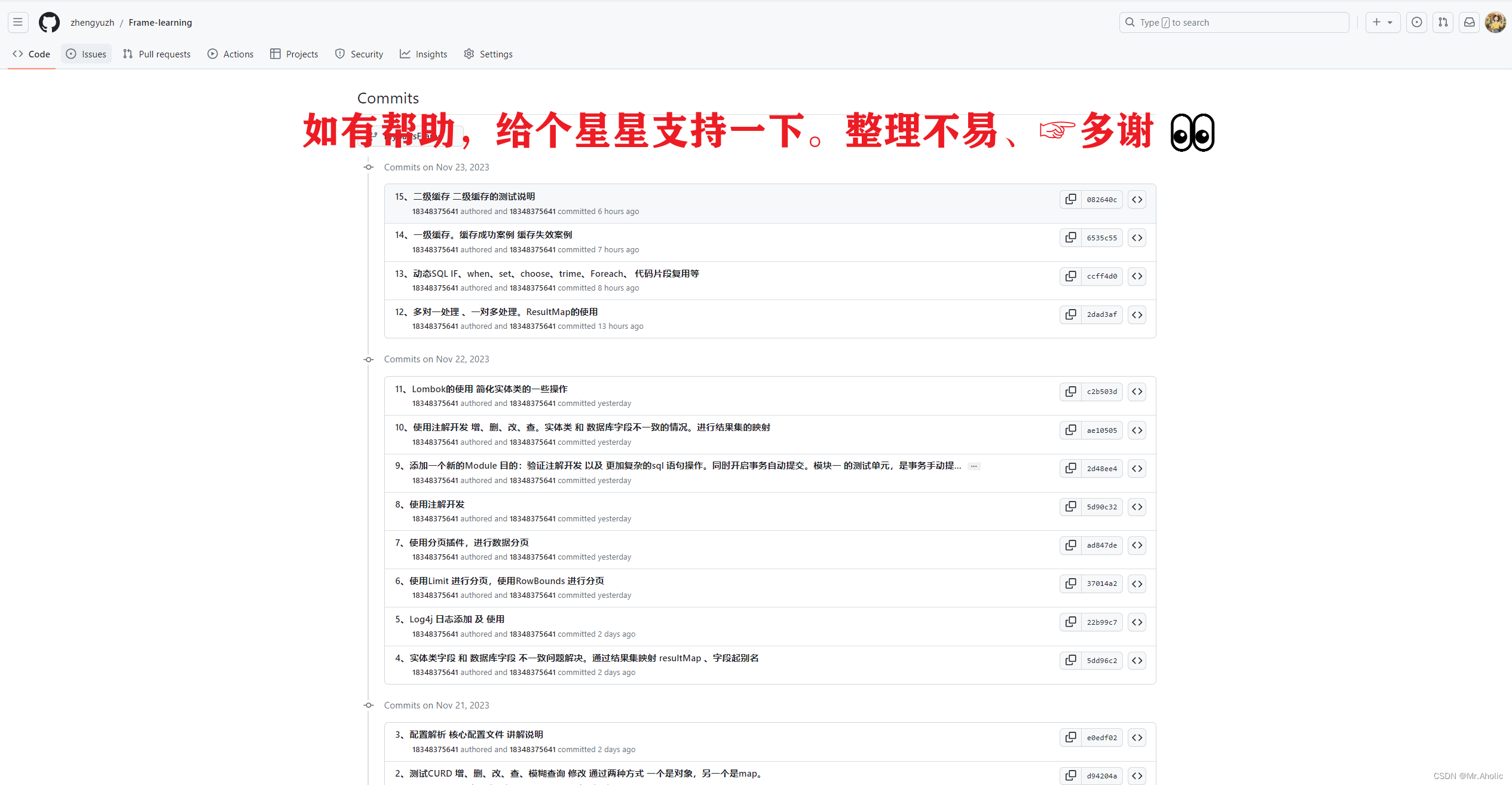
1、Mybatis简介
1.1 什么是Mybatis
如何获得Mybatis
- maven仓库:
<!-- https://mvnrepository.com/artifact/org.mybatis/mybatis -->
<dependency>
<groupId>org.mybatis</groupId>
<artifactId>mybatis</artifactId>
<version>3.5.6</version>
</dependency>
1.2 持久化
数据持久化
- 持久化就是将程序的数据在持久状态和瞬时状态转化的过程
- 内存:断电即失
- 数据库(Jdbc),io文件持久化
- 生活方面例子:冷藏,罐头。
为什么需要持久化?
- 不想丢掉一些对象
- 内存太贵
1.3 持久层
Dao层,Service层,Controller层…
- 完成持久化工作的代码块
- 层界限十分明显
1.4 为什么需要Mybatis?
- 帮助程序猿将数据存入到数据库中
- 方便
- 传统的JDBC代码太复杂,简化–>框架–>自动化
2、第一个Mybatis程序
2.1 搭建环境
整体过程
- 1、新建一个maven项目
- 2、删除src目录
- 3、pom中导入相关依赖(可选)
- 4、新建一个module、目的方便项目扩展
- 5、子项目中也可以导入相关依赖(建议导入子项目,方便区分不同的module)
<dependencies>
<!--mysql driver-->
<dependency>
<groupId>mysql</groupId>
<artifactId>mysql-connector-java</artifactId>
<version>5.1.9</version>
</dependency>
<!--mybatis-->
<dependency>
<groupId>org.mybatis</groupId>
<artifactId>mybatis</artifactId>
<version>3.5.6</version>
</dependency>
<!--junit-->
<dependency>
<groupId>junit</groupId>
<artifactId>junit</artifactId>
<version>4.12</version>
</dependency>
</dependencies>
重点提示 :需要加上如下代码。否则部分代码无法编译道target 目录下,导致运行时报错
<build>
<!--**.xml写在src找不到问题解决方案 -->
<resources>
<resource>
<!-- directory:指定资源文件的位置 -->
<directory>src/main/java</directory>
<includes>
<!-- “**” 表示任意级目录 “*”表示任意任意文件 -->
<!-- mvn resources:resources :对资源做出处理,先于compile阶段 -->
<include>**/*.properties</include>
<include>**/*.xml</include>
</includes>
<!-- filtering:开启过滤,用指定的参数替换directory下的文件中的参数(eg. ${name}) -->
<filtering>false</filtering>
</resource>
<resource>
<directory>src/main/resources</directory>
</resource>
</resources>
</build>
2.2 创建模块
- 编写mybatis的核心配置文件 (这里的mappers 以及起别名 可以后期编写实体类、mapper的相关代码后再写)
<?xml version="1.0" encoding="UTF-8" ?>
<!DOCTYPE configuration
PUBLIC "-//mybatis.org//DTD Config 3.0//EN"
"http://mybatis.org/dtd/mybatis-3-config.dtd">
<!--configuration core file-->
<configuration>
<!--批量设置别名,会自动的将该包下的所有类定义了别名,别名就是其自身且不区分大小-->
<typeAliases>
<package name="com.zyz.mybatis.entity" />
</typeAliases>
<environments default="development">
<environment id="development">
<transactionManager type="JDBC"/>
<dataSource type="POOLED">
<property name="driver" value="com.mysql.jdbc.Driver"/>
<property name="url" value="jdbc:mysql://localhost:3306/spring_test?serverTimezone=UTC&useUnicode=true&characterEncoding=UTF-8&useSSL=false"/>
<property name="username" value="root"/>
<property name="password" value="root"/>
</dataSource>
</environment>
</environments>
<!--加载映射配置文件-->
<mappers>
<mapper resource="com/zyz/mybatis/mapper/StudentMapper.xml"/>
</mappers>
</configuration>
- 编写mybatis 的相关工具类
package com.zyz.mybatis.utils;
import org.apache.ibatis.io.Resources;
import org.apache.ibatis.session.SqlSession;
import org.apache.ibatis.session.SqlSessionFactory;
import org.apache.ibatis.session.SqlSessionFactoryBuilder;
import java.io.InputStream;
/**
* @BelongsProject: Mybatis
* @BelongsPackage: com.zyz.mybatis.utils
* @Author: zhengyuzhu
* @CreateTime: 2023-11-20 16:53
* @Description: 数据库连接工具类 SqlSessionFactory -->SqlSession
* @Version: 1.0
*/
public class MybatisUtils {
private static SqlSessionFactory sqlSessionFactory;
static {
try {
//使用Mybatis第一步:获取sqlSessionFactory对象
String resource = "mybatis-config.xml";
InputStream inputStream = Resources.getResourceAsStream(resource);
sqlSessionFactory = new SqlSessionFactoryBuilder().build(inputStream);
} catch (Exception e) {
e.printStackTrace();
}
}
/**
* @author: zhengyuzhu
* @date: 2023/11/20 16:55
* @return: org.apache.ibatis.session.SqlSession
* @description: 既然有了 SqlSessionFactory,顾名思义,我们可以从中获得 SqlSession 的实例。
* SqlSession 提供了在数据库执行 SQL 命令所需的所有方法。
* 你可以通过 SqlSession 实例来直接执行已映射的 SQL 语句。
**/
public static SqlSession getSqlSession(){
// SqlSession sqlSession = sqlSessionFactory.openSession();
// return sqlSession;
return sqlSessionFactory.openSession();
}
}
2.3 编写代码
实体类 Student
package com.zyz.mybatis.entity;
/**
* @BelongsProject: SpringDemo1
* @BelongsPackage: com.zyz.SpringDemo2.entity
* @Author: zhengyuzhu
* @CreateTime: 2023-11-16 22:33
* @Description: TODO
* @Version: 1.0
*/
public class Student {
private int stuNo;
private String stuName;
private int cardID;
private int classID;
public Student() {
}
public Student(int stuNo, String stuName, int cardID, int classID) {
this.stuNo = stuNo;
this.stuName = stuName;
this.cardID = cardID;
this.classID = classID;
}
public int getStuNo() {
return stuNo;
}
public void setStuNo(int stuNo) {
this.stuNo = stuNo;
}
public String getStuName() {
return stuName;
}
public void setStuName(String stuName) {
this.stuName = stuName;
}
public int getCardID() {
return cardID;
}
public void setCardID(int cardID) {
this.cardID = cardID;
}
public int getClassID() {
return classID;
}
public void setClassID(int classID) {
this.classID = classID;
}
@Override
public String toString() {
return "Student{" +
"stuNo=" + stuNo +
", stuName='" + stuName + '\'' +
", cardID=" + cardID +
", classID=" + classID +
'}';
}
}
mapper接口 StudentMapper 及 xml配置文件 StudentMapper.xml
package com.zyz.mybatis.mapper;
import com.zyz.mybatis.entity.Student;
import java.util.List;
/**
* @author zyz
* @version 1.0
* @data 2023/11/16 22:33
* @Description:
*/
public interface StudentMapper {
/**
* @description: 查询全部
* @author: zhengyuzhu
* @date: 2023/11/16 22:34
* @return: java.util.List<com.zyz.SpringDemo2.entity.Student>
**/
List<Student> queryAll();
/**
* @description: 新增学生
* @author: zhengyuzhu
* @date: 2023/11/16 22:34
* @param: student
**/
void addStudent(Student student);
}
StudentMapper.xml
<?xml version="1.0" encoding="UTF-8" ?>
<!DOCTYPE mapper
PUBLIC "-//mybatis.org//DTD Mapper 3.0//EN"
"http://mybatis.org/dtd/mybatis-3-mapper.dtd">
<mapper namespace="com.zyz.mybatis.mapper.StudentMapper">
<!--查询全部-->
<select id="queryAll" resultType="Student">
select * from student
</select>
<!--新增学生-->
<insert id="addStudent" parameterType="Student">
insert into student (stuno,stuname,cardid,classid)
values (#{stuNo},#{stuName},#{cardID},#{classID})
</insert>
</mapper>2.4 测试单元
/**
* @description: 基本测试
* @author: zhengyuzhu
* @date: 2023/11/20 22:21
**/
@Test
public void test01(){
//第一步:获得SqlSession对象
SqlSession sqlSession = MybatisUtils.getSqlSession();
//方式一:getMapper
StudentMapper studentMapper = sqlSession.getMapper(StudentMapper.class);
List<Student> userList = studentMapper.queryAll();
for (Student student : userList) {
System.out.println(student);
}
//关闭SqlSession
sqlSession.close();
/**
* 输出如下 :
*
* Student{stuNo=1, stuName='张三', cardID=1115, classID=1}
* Student{stuNo=2, stuName='李四', cardID=1116, classID=2}
* Student{stuNo=3, stuName='王五', cardID=1117, classID=3}
*
**/
}
3、测试增删改查(CURD)
提示:我们的实体类,或者数据库中的表,字段或者参数过多,我们应当考虑使用Map!具体案例参考 3.3 修改。修改用户信息的时候,使用了两种方式,一种是通过对象。另外一种是通过map 。有关参数的赋值以及sql语句的字段 获取。都有说明
3.1 添加
mapper 和 xml 配置文件
/**
* @description: 新增学生
* @author: zhengyuzhu
* @date: 2023/11/16 22:34
* @param: student
*
* @return*/
Integer addStudent(Student student);
<!--新增学生-->
<insert id="addStudent" parameterType="Student">
insert into student (stuno, stuname, cardid, classid)
values (#{stuNo}, #{stuName}, #{cardID}, #{classID})
</insert>
测试单元
/**
* @description: 添加对象
* @author: zhengyuzhu
* @date: 2023/11/21 21:06
**/
@Test
public void test04(){
//第一步:获得SqlSession对象
SqlSession sqlSession = MybatisUtils.getSqlSession();
//方式一:getMapper
StudentMapper studentMapper = sqlSession.getMapper(StudentMapper.class);
Student student = new Student();
student.setStuNo(9);
student.setStuName("武松");
student.setClassID(8);
student.setCardID(8);
studentMapper.addStudent(student);
sqlSession.commit();//将数据保存到数据库
Student studentRs = studentMapper.queryStudentById(9);
System.out.println(studentRs);
//关闭SqlSession
sqlSession.close();
/**
* 输出如下 :
* Student{stuNo=9, stuName='武松', cardID=8, classID=8}
*
**/
}3.2 删除
mapper 和 xml 配置文件
/**
* @description:删除学生 通过 学号
* @author: zhengyuzhu
* @date: 2023/11/20 22:45
* @param: stuNo
* @return: java.lang.Integer
**/
Integer deleteStudentById(Integer stuNo);
<delete id="deleteStudentById">
delete
from student
where stuNo = #{stuNo}
</delete>
测试单元
/**
* @description: 删除对象
* @author: zhengyuzhu
* @date: 2023/11/21 21:07
**/
@Test
public void test05(){
//第一步:获得SqlSession对象
SqlSession sqlSession = MybatisUtils.getSqlSession();
StudentMapper studentMapper = sqlSession.getMapper(StudentMapper.class);
studentMapper.deleteStudentById(9);
sqlSession.commit();//将数据保存到数据库
Student studentRs = studentMapper.queryStudentById(9);
System.out.println(studentRs);
//关闭SqlSession
sqlSession.close();
/**
* 输出如下 :
* null
*
**/
}
3.3 修改
mapper 和 xml 配置文件
一个是通过对象的方式修改,一个是通过 map
/**
* @description: 修改学生信息
* @author: zhengyuzhu
* @date: 2023/11/20 22:45
* @param: student
* @return: java.lang.Integer
**/
Integer updateStudent(Student student);
/**
* @description: 通过Map 修改学生信息
* @author: zhengyuzhu
* @date: 2023/11/21 21:08
* @param: studentMap
* @return: java.lang.Integer
**/
Integer updateStudentMap(HashMap<String,Object> studentMap);
<update id="updateStudent" parameterType="Student">
update student
set stuNo = #{stuNo},
stuName = #{stuName},
cardid = #{cardID},
classid = #{classID}
where stuNo = #{stuNo}
</update>
<update id="updateStudentMap" parameterType="map">
update student
set stuNo = #{stuNo},
stuName = #{stuName},
cardid = #{cardid},
classid = #{classid}
where stuNo = #{stuNo}
</update>
测试单元
/**
* @description: 修改对象信息 通过Map
* @author: zhengyuzhu
* @date: 2023/11/20 23:02
**/
@Test
public void test02(){
//第一步:获得SqlSession对象
SqlSession sqlSession = MybatisUtils.getSqlSession();
//方式一:getMapper
StudentMapper studentMapper = sqlSession.getMapper(StudentMapper.class);
HashMap<String, Object> stuMap = new HashMap<>();
stuMap.put("stuNo",1);
stuMap.put("stuName","李白");
stuMap.put("cardid",6);
stuMap.put("classid",6);
Integer rs = studentMapper.updateStudentMap(stuMap);
Student student = studentMapper.queryStudentById(1);
System.out.println(student);
//关闭SqlSession
sqlSession.close();
/**
* 输出如下 :
*
* Student{stuNo=1, stuName='张三', cardID=1115, classID=1}
* Student{stuNo=2, stuName='李四', cardID=1116, classID=2}
* Student{stuNo=3, stuName='王五', cardID=1117, classID=3}
*
**/
}
/**
* @description: 修改对象信息 通过 Student 对象
* @author: zhengyuzhu
* @date: 2023/11/20 23:02
**/
@Test
public void test03(){
//第一步:获得SqlSession对象
SqlSession sqlSession = MybatisUtils.getSqlSession();
//方式一:getMapper
StudentMapper studentMapper = sqlSession.getMapper(StudentMapper.class);
Student studentBefore = studentMapper.queryStudentById(0);
System.out.println("修改前的学生信息 : " + studentBefore);
Student student = new Student();
student.setStuNo(0);
student.setStuName("麻子嘞");
student.setClassID(6);
student.setCardID(6);
studentMapper.updateStudent(student);
sqlSession.commit();//将数据保存到数据库
Student studentAfter = studentMapper.queryStudentById(0);
System.out.println("修改后的学生信息 : " + studentAfter);
//关闭SqlSession
sqlSession.close();
/**
* 输出如下 :
*
* 修改前的学生信息 : Student{stuNo=0, stuName='李四', cardID=8, classID=8}
* 修改后的学生信息 : Student{stuNo=0, stuName='麻子嘞', cardID=6, classID=6}
*
**/
}
3.4 查询
mapper 和 xml 配置文件
/**
* @description: 查询全部
* @author: zhengyuzhu
* @date: 2023/11/16 22:34
* @return: java.util.List<com.zyz.SpringDemo2.entity.Student>
**/
List<Student> queryAll();
/**
* @description:删除学生 通过 学号
* @author: zhengyuzhu
* @date: 2023/11/20 22:45
* @param: stuNo
* @return: java.lang.Integer
**/
Integer deleteStudentById(Integer stuNo);
<!--查询全部-->
<select id="queryAll" resultType="Student">
select *
from student
</select>
<select id="queryStudentById" resultType="com.zyz.mybatis.entity.Student">
select *
from student
where stuNo = #{stuNo}
</select>
测试单元
/**
* @description: 基本测试
* @author: zhengyuzhu
* @date: 2023/11/20 22:21
**/
@Test
public void test01(){
//第一步:获得SqlSession对象
SqlSession sqlSession = MybatisUtils.getSqlSession();
//方式一:getMapper
StudentMapper studentMapper = sqlSession.getMapper(StudentMapper.class);
List<Student> userList = studentMapper.queryAll();
for (Student student : userList) {
System.out.println(student);
}
//关闭SqlSession
sqlSession.close();
/**
* 输出如下 :
*
* Student{stuNo=1, stuName='张三', cardID=1115, classID=1}
* Student{stuNo=2, stuName='李四', cardID=1116, classID=2}
* Student{stuNo=3, stuName='王五', cardID=1117, classID=3}
*
**/
}
3.5 模糊查询
- 1、java代码执行的时候,传递通配符% %
/**
* @description: 模糊查询
* @author: zhengyuzhu
* @date: 2023/11/21 21:39
* @param: like
* @return: java.util.List<com.zyz.mybatis.entity.Student>
**/
List<Student> getStudentLike(String value);
- 2、在sql拼接中使用通配符!
<!--模糊查询-->
<select id="getStudentLike" resultType="com.zyz.mybatis.entity.Student">
select * from student where stuname like "%"#{value}"%"
</select>
测试单元
/**
* @description: 模糊查询
* @author: zhengyuzhu
* @date: 2023/11/21 21:41
**/
@Test
public void test06(){
//第一步:获得SqlSession对象
SqlSession sqlSession = MybatisUtils.getSqlSession();
//方式一:getMapper
StudentMapper studentMapper = sqlSession.getMapper(StudentMapper.class);
List<Student> userList = studentMapper.getStudentLike("%李%");
for (Student student : userList) {
System.out.println(student);
}
//关闭SqlSession
sqlSession.close();
/**
* 输出如下 :
*
* Student{stuNo=2, stuName='李四', cardID=1116, classID=2}
* Student{stuNo=8, stuName='李老头', cardID=8, classID=8}
*
**/
}
4、配置解析
可以参考官网的更加详细的说明,这里对常用的属性进行说明
MyBatis 的配置文件包含了会深深影响 MyBatis 行为的设置和属性信息。 配置文档的顶层结构如下:
- configuration(配置)
- environment(环境变量)
- transactionManager(事务管理器)
- dataSource(数据源)
4.1 属性
我们可以通过properties属性来实现引用配置文件
这些属性都是可外部配置且可动态替换的,既可以在典型的Java属性文件中配置,亦可通过properties元素的子元素来传递。【db.properties】
编写一个配置文件
db.properties
jdbc.driver=com.mysql.jdbc.Driver
jdbc.url=jdbc:mysql://localhost:3306/spring_test?serverTimezone=UTC&useUnicode=true&characterEncoding=UTF-8&useSSL=false
jdbc.username=root
jdbc.password=root
在核心配置文件中映入
<!--
引入外部配置文件
这些属性可以在外部进行配置,并可以进行动态替换。你既可以在典型的 Java 属性文件中配置这些属性,
也可以在 properties 元素的子元素中设置。例如:
-->
<properties resource="db.properties">
<property name="username" value="root"/>
<property name="password" value="root"/>
</properties>
<dataSource type="POOLED">
<!--
设置好的属性可以在整个配置文件中用来替换需要动态配置的属性值。比如:
这个例子中的 username 和 password 将会由 properties 元素中设置的相应值来替换。
driver 和 url 属性将会由 db.properties 文件中对应的值来替换。这样就为配置提供了诸多灵活选择。
-->
<property name="driver" value="${jdbc.driver}"/>
<property name="url" value="${jdbc.url}"/>
<property name="username" value="${username}"/>
<property name="password" value="${password}"/>
</dataSource>4.2 设置
设置 参考官网介绍 这里掠过
4.3 类型别名
- 类型别名是为Java类型设置一个短的名字。
- 存在的意义仅在于用来减少类完全限定名的冗余。
第一种:实体类较少的情况。单独起别名
<!--可以给实体类起别名-->
<typeAliases>
<typeAlias type="com.zyz.mybatis.entity.Student" alias="student" />
</typeAliases>
第二种:当实体类很多的时候,可以使用package的形式,会自动的将该包下的所有类定义了别名,别名就是其自身且不区分大小
<typeAliases>
<package name="com.zyz.mybatis.entity" />
</typeAliases>
第一种可以DIY别名,第二种则不行,如果非要改,需要在实体上增加注解
@Alias("author")
public class Author {
...
}
4.4类型处理器(typeHandlers)
MyBatis 在设置预处理语句(PreparedStatement)中的参数或从结果集中取出一个值时, 都会用类型处理器将获取到的值以合适的方式转换成 Java 类型。下表描述了一些默认的类型处理器。
类型处理器 参考官网介绍 这里掠过
4.5 对象工厂
每次 MyBatis 创建结果对象的新实例时,它都会使用一个对象工厂(ObjectFactory)实例来完成实例化工作。 默认的对象工厂需要做的仅仅是实例化目标类,要么通过默认无参构造方法,要么通过存在的参数映射来调用带有参数的构造方法。 如果想覆盖对象工厂的默认行为,可以通过创建自己的对象工厂来实现
对象工厂 参考官网介绍 这里掠过
4.6 插件(plugins)
具体使用参考官网,略
4.7 环境配置
- environment(环境变量)
- transactionManager(事务管理器)
- dataSource(数据源)
MyBatis 可以配置成适应多种环境,这种机制有助于将 SQL 映射应用于多种数据库之中, 现实情况下有多种理由需要这么做。例如,开发、测试和生产环境需要有不同的配置;或者想在具有相同 Schema 的多个生产数据库中使用相同的 SQL 映射。还有许多类似的使用场景。
不过要记住:尽管可以配置多个环境,但每个 SqlSessionFactory 实例只能选择一种环境。
environments 元素定义了如何配置环境。
<environments default="development">
<environment id="development">
<transactionManager type="JDBC">
<property name="..." value="..."/>
</transactionManager>
<dataSource type="POOLED">
<property name="driver" value="${driver}"/>
<property name="url" value="${url}"/>
<property name="username" value="${username}"/>
<property name="password" value="${password}"/>
</dataSource>
</environment>
</environments>注意一些关键点:
- 默认使用的环境 ID(比如:default="development")。
- 每个 environment 元素定义的环境 ID(比如:id="development")。
- 事务管理器的配置(比如:type="JDBC")。
- 数据源的配置(比如:type="POOLED")。
默认环境和环境 ID 顾名思义。 环境可以随意命名,但务必保证默认的环境 ID 要匹配其中一个环境 ID。
4.7.1 environment (环境变量)
注意一些关键点:
- 默认使用的环境 ID(比如:default="development")。
- 每个 environment 元素定义的环境 ID(比如:id="development")。
- 事务管理器的配置(比如:type="JDBC")。
- 数据源的配置(比如:type="POOLED")。
默认环境和环境 ID 顾名思义。 环境可以随意命名,但务必保证默认的环境 ID 要匹配其中一个环境 ID。
4.7.2 transactionManager(事务管理器)
如果你正在使用 Spring + MyBatis,则没有必要配置事务管理器,因为 Spring 模块会使用自带的管理器来覆盖前面的配置。
这两种事务管理器类型都不需要设置任何属性。它们其实是类型别名,换句话说,你可以用 TransactionFactory 接口实现类的全限定名或类型别名代替它们。
在 MyBatis 中有两种类型的事务管理器(也就是 type="[JDBC|MANAGED]"):
- 1、JDBC – 这个配置直接使用了 JDBC 的提交和回滚功能,它依赖从数据源获得的连接来管理事务作用域。默认情况下,为了与某些驱动程序兼容,它在关闭连接时启用自动提交。然而,对于某些驱动程序来说,启用自动提交不仅是不必要的,而且是一个代价高昂的操作。因此,从 3.5.10 版本开始,你可以通过将 "skipSetAutoCommitOnClose" 属性设置为 "true" 来跳过这个步骤:例如
<transactionManager type="JDBC">
<property name="skipSetAutoCommitOnClose" value="true"/>
</transactionManager>
- MANAGED – 这个配置几乎没做什么。它从不提交或回滚一个连接,而是让容器来管理事务的整个生命周期(比如 JEE 应用服务器的上下文)。 默认情况下它会关闭连接。然而一些容器并不希望连接被关闭,因此需要将 closeConnection 属性设置为 false 来阻止默认的关闭行为
<transactionManager type="MANAGED">
<property name="closeConnection" value="false"/>
</transactionManager>
4.7.3 dataSource(数据源)
dataSource 元素使用标准的 JDBC 数据源接口来配置 JDBC 连接对象的资源。
大多数 MyBatis 应用程序会按示例中的例子来配置数据源。虽然数据源配置是可选的,但如果要启用延迟加载特性,就必须配置数据源。
有三种内建的数据源类型(也就是 type="[UNPOOLED|POOLED|JNDI]"):
- 1、UNPOOLED– 这个数据源的实现会每次请求时打开和关闭连接。虽然有点慢,但对那些数据库连接可用性要求不高的简单应用程序来说,是一个很好的选择。 性能表现则依赖于使用的数据库,对某些数据库来说,使用连接池并不重要,这个配置就很适合这种情形。
- 2、POOLED– 这种数据源的实现利用“池”的概念将 JDBC 连接对象组织起来,避免了创建新的连接实例时所必需的初始化和认证时间。 这种处理方式很流行,能使并发 Web 应用快速响应请求。
- 3、JNDI – 这个数据源实现是为了能在如 EJB 或应用服务器这类容器中使用,容器可以集中或在外部配置数据源,然后放置一个 JNDI 上下文的数据源引用
4.8 数据库厂商标识
具体参考官网,这里掠过
4.9 映射器
既然 MyBatis 的行为已经由上述元素配置完了,我们现在就要来定义 SQL 映射语句了。 但首先,我们需要告诉 MyBatis 到哪里去找到这些语句。 在自动查找资源方面,Java 并没有提供一个很好的解决方案,所以最好的办法是直接告诉 MyBatis 到哪里去找映射文件。
注意点:
- 接口和它的Mapper配置文件必须同名!
- 接口和它的Mapper配置文件必须在同一个包下!
四种方式
- 1、第一种:使用相对于类路径的资源引用
<mappers>
<mapper resource="org/mybatis/builder/AuthorMapper.xml"/>
<mapper resource="org/mybatis/builder/BlogMapper.xml"/>
<mapper resource="org/mybatis/builder/PostMapper.xml"/>
</mappers>- 2、第二种:使用完全限定资源定位符(URL)
<mappers>
<mapper url="file:///var/mappers/AuthorMapper.xml"/>
<mapper url="file:///var/mappers/BlogMapper.xml"/>
<mapper url="file:///var/mappers/PostMapper.xml"/>
</mappers>- 3、第三种:使用映射器接口实现类的完全限定类名
<mappers>
<mapper class="org.mybatis.builder.AuthorMapper"/>
<mapper class="org.mybatis.builder.BlogMapper"/>
<mapper class="org.mybatis.builder.PostMapper"/>
</mappers>- 4、第四种:将包内的映射器接口全部注册为映射器 【使用的最多】
<mappers>
<package name="org.mybatis.builder"/>
</mappers>
4.10 完整的配置文件(实战)
4.10.1 db.properties
jdbc.driver=com.mysql.jdbc.Driver
jdbc.url=jdbc:mysql://localhost:3306/spring_test?serverTimezone=UTC&useUnicode=true&characterEncoding=UTF-8&useSSL=false
jdbc.username=root
jdbc.password=root
4.10.2 mybatis-config.xml
<?xml version="1.0" encoding="UTF-8" ?>
<!DOCTYPE configuration
PUBLIC "-//mybatis.org//DTD Config 3.0//EN"
"http://mybatis.org/dtd/mybatis-3-config.dtd">
<!--configuration core file-->
<configuration>
<!--
引入外部配置文件
这些属性可以在外部进行配置,并可以进行动态替换。你既可以在典型的 Java 属性文件中配置这些属性,
也可以在 properties 元素的子元素中设置。例如:
-->
<properties resource="db.properties">
<property name="username" value="root"/>
<property name="password" value="root"/>
</properties>
<!--
1、可以给实体类起别名
<typeAliases>
<typeAlias type="com.zyz.mybatis.entity.Student" alias="student" />
</typeAliases>
2、 批量设置别名,会自动的将该包下的所有类定义了别名,别名就是其自身且不区分大小
-->
<typeAliases>
<package name="com.zyz.mybatis.entity" />
</typeAliases>
<!--
MyBatis 可以配置成适应多种环境,这种机制有助于将 SQL 映射应用于多种数据库之中, 现实情况下有多种理由需要这么做。
例如,开发、测试和生产环境需要有不同的配置;或者想在具有相同 Schema 的多个生产数据库中使用相同的 SQL 映射。还有许多类似的使用场景。
不过要记住:尽管可以配置多个环境,但每个 SqlSessionFactory 实例只能选择一种环境
注意一些关键点:
默认使用的环境 ID(比如:default="development")。
每个 environment 元素定义的环境 ID(比如:id="development")。
事务管理器的配置(比如:type="JDBC")。
数据源的配置(比如:type="POOLED")。
默认环境和环境 ID 顾名思义。 环境可以随意命名,但务必保证默认的环境 ID 要匹配其中一个环境 ID。
-->
<environments default="development">
<environment id="development">
<!--
JDBC – 这个配置直接使用了 JDBC 的提交和回滚功能,它依赖从数据源获得的连接来管理事务作用域。
默认情况下,为了与某些驱动程序兼容,它在关闭连接时启用自动提交。
-->
<transactionManager type="JDBC"/>
<!--
dataSource 元素使用标准的 JDBC 数据源接口来配置 JDBC 连接对象的资源
大多数 MyBatis 应用程序会按示例中的例子来配置数据源。虽然数据源配置是可选的,但如果要启用延迟加载特性,就必须配置数据源。
POOLED– 这种数据源的实现利用“池”的概念将 JDBC 连接对象组织起来,避免了创建新的连接实例时所必需的初始化和认证时间。
这种处理方式很流行,能使并发 Web 应用快速响应请求。
-->
<dataSource type="POOLED">
<!--
设置好的属性可以在整个配置文件中用来替换需要动态配置的属性值。比如:
这个例子中的 username 和 password 将会由 properties 元素中设置的相应值来替换。
driver 和 url 属性将会由 db.properties 文件中对应的值来替换。这样就为配置提供了诸多灵活选择。
-->
<property name="driver" value="${jdbc.driver}"/>
<property name="url" value="${jdbc.url}"/>
<property name="username" value="${username}"/>
<property name="password" value="${password}"/>
</dataSource>
</environment>
</environments>
<!--
加载映射配置文件
既然 MyBatis 的行为已经由上述元素配置完了,我们现在就要来定义 SQL 映射语句了。
但首先,我们需要告诉 MyBatis 到哪里去找到这些语句。 在自动查找资源方面,Java 并没有提供一个很好的解决方案,
所以最好的办法是直接告诉 MyBatis 到哪里去找映射文件。
你可以使用相对于
1、类路径的资源引用
2、完全限定资源定位符(包括 file:/// 形式的 URL)
3、类名
4、包名:
-->
<!-- 1、使用相对于类路径的资源引用 -->
<mappers>
<mapper resource="com/zyz/mybatis/mapper/StudentMapper.xml"/>
</mappers>
<!--
2、使用完全限定资源定位符(URL)
<mappers>
<mapper url="file:///var/mappers/AuthorMapper.xml"/>
<mapper url="file:///var/mappers/BlogMapper.xml"/>
<mapper url="file:///var/mappers/PostMapper.xml"/>
</mappers>
-->
<!--
3、使用映射器接口实现类的完全限定类名
<mappers>
<mapper class="org.mybatis.builder.AuthorMapper"/>
<mapper class="org.mybatis.builder.BlogMapper"/>
<mapper class="org.mybatis.builder.PostMapper"/>
</mappers>
-->
<!--
4、将包内的映射器接口全部注册为映射器
<mappers>
<package name="org.mybatis.builder"/>
</mappers>
-->
</configuration>
4.10.3 项目结构

5、解决属性名和字段名不一致的问题
数据库 和 实体类对应关系如下:
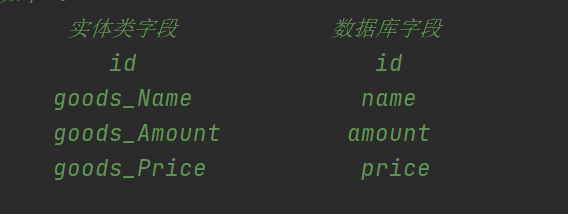
5.1 通过字段别名解决
2、通过给字段起别名解决
<select id="queryGoodsById" resultType="com.zyz.mybatis.entity.Goods">
select id,name as goods_Name,amount as goods_Amount,price as goods_Price
from goods
where id = #{id}
</select>5.2 通过结果集映射(resultMap)
3、通过结果集映射
<select id="queryGoodsById" resultMap="GoodsMap">
select *
from goods
where id = #{id}
</select>
<!-- 结果集映射 -->
<resultMap id="GoodsMap" type="Goods">
<!--column数据库中的字段,property实体类中的属性-->
<result column="id" property="id" />
<result column="name" property="goods_Name" />
<result column="amount" property="goods_Amount" />
<result column="price" property="goods_Price" />
</resultMap>
测试单元
/**
* @description: 测试查询商品信息 数据库字段 和 实体类字段不一致问题
* @author: zhengyuzhu
* @date: 2023/11/22 9:19
**/
@Test
public void testDemo1(){
//第一步:获得SqlSession对象
SqlSession sqlSession = MybatisUtils.getSqlSession();
//方式一:getMapper
GoodsMapper goodsMapper = sqlSession.getMapper(GoodsMapper.class);
Goods goods = goodsMapper.queryGoodsById(1001);
System.out.println(goods);
//关闭SqlSession
sqlSession.close();
/**
* 输出如下 :
* 实体类字段 数据库字段
* id id
* goods_Name name
* goods_Amount amount
* goods_Price price
*
* Goods{id=1001, goods_Name='null', goods_Amount=null, goods_Price=null}
*
*
*
* 第一种方式:字段起别名:
* select id,name as goods_Name,amount as goods_Amount,price as goods_Price
*
* Goods{id=1001, goods_Name='茶杯', goods_Amount=10, goods_Price=13.6}
*
*
* 第二种方式:结果集映射:
* 具体实现查看 GoodsMapper.xml 文件注释描述
*
* Goods{id=1001, goods_Name='茶杯', goods_Amount=10, goods_Price=13.6}
*
**/
}
6、日志
Mybatis 通过使用内置的日志工厂提供日志功能。内置日志工厂将会把日志工作委托给下面的实现之一:
- SLF4J
- Apache Commons Logging
- Log4j 2
- Log4j(3.5.9起废弃)
- JDK logging
MyBatis 内置日志工厂基于运行时自省机制选择合适的日志工具。
6.1 Log4j 的使用
什么是Log4j?
- Log4j是Apache的一个开源项目,通过使用Log4j,我们可以控制日志信息输送的目的地是控制台、文件、GUI组件
- 我们也可以控制每一条日志的输出格式;
- 通过定义每一条日志信息的级别,我们能够更加细致地控制日志的生成过程。
- 可以通过一个配置文件来灵活地进行配置,而不需要修改应用的代码。
具体使用过程如下:
1、先在pom.xml文件中导入log4j的依赖包
<!-- Log4j 配置 -->
<dependency>
<groupId>log4j</groupId>
<artifactId>log4j</artifactId>
<version>1.2.17</version>
</dependency>
2、在resources文件夹下建立log4j.properties文件进行配置
这里将 文件输出的位置 放在根目录 ./log/zyz.log
#将等级为DEBUG的日志信息输出到console和file这两个目的地,console和file的定义在下面的代码
log4j.rootLogger = DEBUG,console ,file
#控制台输出的相关设置
log4j.appender.console = org.apache.log4j.ConsoleAppender
log4j.appender.console.Target = System.out
log4j.appender.console.Threshold = DEBUG
log4j.appender.console.layout = org.apache.log4j.PatternLayout
log4j.appender.console.layout.ConversionPattern = [%c]-%m%n
#文件输出的相关设置
log4j.appender.file = org.apache.log4j.RollingFileAppender
log4j.appender.file.File = ./log/zyz.log
log4j.appender.file.MaxFileSize = 10mb
log4j.appender.file.Threshold = DEBUG
log4j.appender.file.layout = org.apache.log4j.PatternLayout
log4j.appender.file.layout.ConversionPattern = [%p][%d{yy-MM-dd}][%c]%m%n
#日志输出级别
log4j.logger.org.mybatis=DEBUG
log4j.logger.java.sql=DEBUG
log4j.logger.java.sql.Statement=DEBUG
log4j.logger.java.sql.ResultSet=DEBUG
log4j.logger.java.sql.PreparedStatement=DEBUG
3、在mybatis-config.xml核心配置文件中,配置log4j为日志的实现!
<settings>
<setting name="logImpl" value="LOG4J"/>
</settings>
4、Log4j的使用,直接测试运行
在被测试的类中添加 这段信息
static Logger logger = Logger.getLogger(TestGoods.class);
import com.zyz.mybatis.entity.Goods;
import com.zyz.mybatis.mapper.GoodsMapper;
import com.zyz.mybatis.utils.MybatisUtils;
import org.apache.ibatis.session.SqlSession;
import org.apache.log4j.Logger;
import org.junit.Test;
/**
* @BelongsProject: Mybatis
* @BelongsPackage: PACKAGE_NAME
* @Author: zhengyuzhu
* @CreateTime: 2023-11-22 09:19
* @Description: TODO
* @Version: 1.0
*/
public class TestGoods {
static Logger logger = Logger.getLogger(TestGoods.class);
/**
* @description: 测试日志打印
* @author: zhengyuzhu
* @date: 2023/11/22 10:03
**/
@Test
public void testDemo2(){
logger.info("INFO 日志测试");
logger.debug("DEBUG 日志测试");
logger.error("ERROR 日志测试");
}
}
输出结果入下:
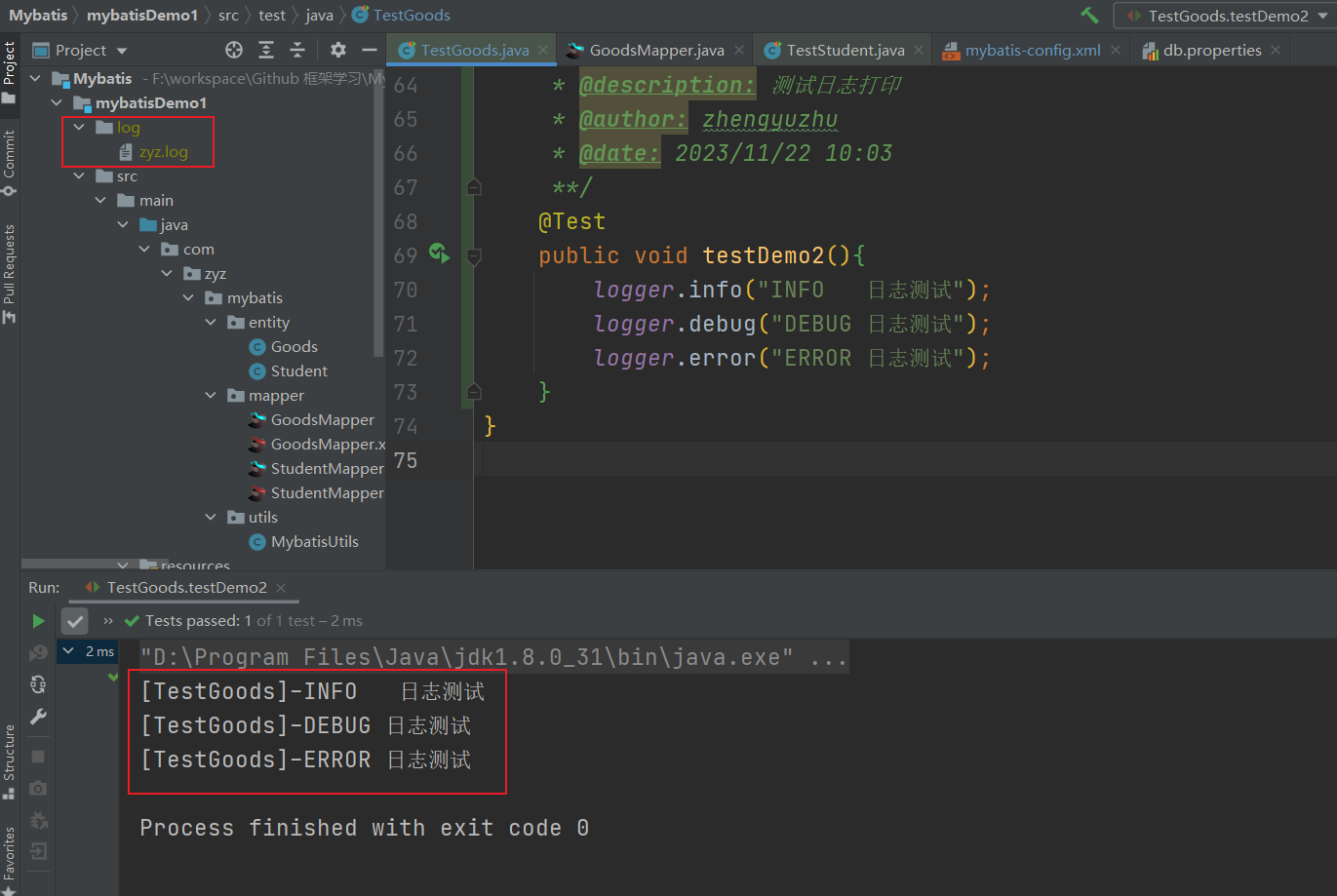


7、分页
思考:为什么要分页!
- 减少数据的处理量
7.1 使用Limit分页
语法:SELECT * from user limit startIndex,pageSize
SELECT * from user limit 3 #[0,n]
1、接口
/**
* @description: 使用 limit 分页查询数据
* @author: zhengyuzhu
* @date: 2023/11/22 10:56
* @param: map
* @return: java.util.List<com.zyz.mybatis.entity.Goods>
**/
List<Goods> queryGoodsLimit(Map<String,Object> map);2、GoodsMapper.xml 文件
<!--分页查询数据-->
<select id="queryGoodsLimit" resultMap="GoodsMap">
select *
from goods limit #{startIndex},#{pageSize}
</select>
<!-- 结果集映射 -->
<resultMap id="GoodsMap" type="Goods">
<!--column数据库中的字段,property实体类中的属性-->
<result column="id" property="id" />
<result column="name" property="goods_Name" />
<result column="amount" property="goods_Amount" />
<result column="price" property="goods_Price" />
</resultMap>
3、测试单元
/**
* @description: limit 分页查询数据
* @author: zhengyuzhu
* @date: 2023/11/22 10:59
**/
@Test
public void testDemo3(){
//第一步:获得SqlSession对象
SqlSession sqlSession = MybatisUtils.getSqlSession();
//方式一:getMapper
GoodsMapper goodsMapper = sqlSession.getMapper(GoodsMapper.class);
HashMap<String, Object> goodsMap = new HashMap<String, Object>();
goodsMap.put("startIndex",0);
goodsMap.put("pageSize",3);
List<Goods> goodsList = goodsMapper.queryGoodsLimit(goodsMap);
for(Goods goods : goodsList){
logger.info(goods);
}
//关闭SqlSession
sqlSession.close();
/**
* 输出如下 :
*
* [com.zyz.mybatis.mapper.GoodsMapper.queryGoodsLimit]-==> Preparing: select * from goods limit ?,?
* [com.zyz.mybatis.mapper.GoodsMapper.queryGoodsLimit]-==> Parameters: 0(Integer), 3(Integer)
* [com.zyz.mybatis.mapper.GoodsMapper.queryGoodsLimit]-<== Total: 3
* [TestGoods]-Goods{id=1001, goods_Name='茶杯', goods_Amount=10, goods_Price=13.6}
* [TestGoods]-Goods{id=1002, goods_Name='茶壶', goods_Amount=10, goods_Price=15.9}
* [TestGoods]-Goods{id=1003, goods_Name='保温杯', goods_Amount=10, goods_Price=23.6}
*
**/
}7.2 RowBounds分页
1.接口
/**
* @description: 使用 RowBounds 分页
* @author: zhengyuzhu
* @date: 2023/11/22 11:12
* @return: java.util.List<com.zyz.mybatis.entity.Goods>
**/
List<Goods> queryGoodsByRowBounds();
2 .GoodsMapper.xml 文件
<!--使用 RowBounds 分页-->
<select id="queryGoodsByRowBounds" resultMap="GoodsMap">
select * from goods
</select>
<!-- 结果集映射 -->
<resultMap id="GoodsMap" type="Goods">
<!--column数据库中的字段,property实体类中的属性-->
<result column="id" property="id" />
<result column="name" property="goods_Name" />
<result column="amount" property="goods_Amount" />
<result column="price" property="goods_Price" />
</resultMap>
3.测试单元
/**
* @description: 2、使用 RowBounds 分页
* @author: zhengyuzhu
* @date: 2023/11/22 11:14
**/
@Test
public void testDemo4(){
//第一步:获得SqlSession对象
SqlSession sqlSession = MybatisUtils.getSqlSession();
// RowBounds 实现
RowBounds rowBounds = new RowBounds(0, 2);
List<Goods> goodsList = sqlSession.selectList("com.zyz.mybatis.mapper.GoodsMapper.queryGoodsByRowBounds",null,rowBounds);
for(Goods goods : goodsList){
logger.info(goods);
}
//关闭SqlSession
sqlSession.close();
/**
* 输出如下 :
*
* [org.apache.ibatis.transaction.jdbc.JdbcTransaction]-Setting autocommit to false on JDBC Connection [com.mysql.jdbc.JDBC4Connection@77a57272]
* [com.zyz.mybatis.mapper.GoodsMapper.queryGoodsByRowBounds]-==> Preparing: select * from goods
* [com.zyz.mybatis.mapper.GoodsMapper.queryGoodsByRowBounds]-==> Parameters:
* [TestGoods]-Goods{id=1001, goods_Name='茶杯', goods_Amount=10, goods_Price=13.6}
* [TestGoods]-Goods{id=1002, goods_Name='茶壶', goods_Amount=10, goods_Price=15.9}
*
**/
}
7.3 分页插件
官网介绍:链接https://pagehelper.github.io/

使用分页插件的流程:
- 1、在maven中引入PageHelper和jsqlparser
- 2、mybatis-config.xml中增加plugin配置
- 3、代码中使用PageHelper.startPage() 自动分页
1、首先,在maven中引入PageHelper和jsqlparser
<!--分页插件-->
<dependency>
<groupId>com.github.pagehelper</groupId>
<artifactId>pagehelper</artifactId>
<version>5.1.4</version>
</dependency>
<dependency>
<groupId>com.github.jsqlparser</groupId>
<artifactId>jsqlparser</artifactId>
<version>1.4</version>
</dependency>
说明:
(1)jsqlparser的版本需要是2.0及以上的版本;因为5.1.10之前的PageHelper并没有对jsqlparser版本作要求;但是5.1.10及以后的PageHelper采用了新的API,所以jsqlparser的版本需要是2.0及以上的版本才可以;【我这里退回 1.4 可以正常使用】
(2)PageHelper执行原理:PageHelper在原有的要执行的SQL基础上,进行分析,自动生成分页以及【select count(*) from…】这样的语句;因为,涉及到原始SQL的分析与解析,所以需要引入jsqlparser这个SQL解析器组件啦;
2、mybatis-config.xml中增加plugin配置
参数详解:Mybatis-PageHelper
官网:官网文档
plugins插件是mybatis的一个特色,通过插件可以扩展mybatis的能力;
(2)interceptor属性:代表拦截器,需要配置PageHelper的核心类;
(3)helperDialect配置项和reasonable配置项(在PageHelper的官网文档中有详细说明)
<plugins>
<!-- com.github.pagehelper为PageHelper类所在包名 -->
<plugin interceptor="com.github.pagehelper.PageInterceptor">
<!--
使用下面的方式配置参数
helperDialect:分页插件会自动检测当前的数据库链接,自动选择合适的分页方式。
你可以配置helperDialect属性来指定分页插件使用哪种方言 配置时,可以使用下面的缩写值:
oracle,mysql,mariadb,sqlite,hsqldb,postgresql,db2,sqlserver,informix,h2,sqlserver2012,derby
reasonable:分页合理化参数,默认值为false。当该参数设置为 true 时,pageNum<=0 时会查询第一页, pageNum>pages(超过总数时),会查询最后一页。
默认false 时,直接根据参数进行查询。
更多参数配置:参考官网
-->
<property name="helperDialect" value="mysql"/>
<property name="reasonable" value="true"/>
</plugin>
</plugins>
3、测试单元
/**
* @description: 3、使用分页插件
* @author: zhengyuzhu
* @date: 2023/11/22 13:43
**/
@Test
public void testDemo5(){
//第一步:获得SqlSession对象
SqlSession sqlSession = MybatisUtils.getSqlSession();
// PageHelper.startPage()对即将到来的下一次查询进行分页处理;
// 比如下面就是第1页,每页2条数据;
PageHelper.startPage(1, 2);
GoodsMapper goodsMapper = sqlSession.getMapper(GoodsMapper.class);
List<Goods> goodsList = goodsMapper.queryGoodByPlugin();
//用PageInfo对结果进行包装
PageInfo page = new PageInfo(goodsList);
System.out.println("总页数:"+page.getPages());
System.out.println("总记录数:"+page.getTotal());
System.out.println("开始行号:"+page.getStartRow());
System.out.println("结束行号:"+page.getEndRow());
System.out.println("当前页码:"+page.getPageNum());
List<Goods> goodsListRs = page.getList();
for(Goods goods : goodsListRs){
logger.info(goods);
}
//关闭SqlSession
sqlSession.close();
/**
* 输出如下 :
*
[com.zyz.mybatis.mapper.GoodsMapper.queryGoodByPlugin_COUNT]-==> Preparing: SELECT count(0) FROM goods
[com.zyz.mybatis.mapper.GoodsMapper.queryGoodByPlugin_COUNT]-==> Parameters:
[com.zyz.mybatis.mapper.GoodsMapper.queryGoodByPlugin_COUNT]-<== Total: 1
[com.zyz.mybatis.mapper.GoodsMapper.queryGoodByPlugin]-==> Preparing: select * from goods LIMIT ?
[com.zyz.mybatis.mapper.GoodsMapper.queryGoodByPlugin]-==> Parameters: 2(Integer)
[com.zyz.mybatis.mapper.GoodsMapper.queryGoodByPlugin]-<== Total: 2
总页数:2
总记录数:4
开始行号:1
结束行号:2
当前页码:1
[TestGoods]-Goods{id=1001, goods_Name='茶杯', goods_Amount=10, goods_Price=13.6}
[TestGoods]-Goods{id=1002, goods_Name='茶壶', goods_Amount=10, goods_Price=15.9}
**/
}
8、使用注解开发
8.1 面向接口编程
- 之前学过面向对象编程,也学习过接口,但在真正的开发中,很多时候会选择面向接口编程。
- 根本原因:解耦,可拓展,提高复用,分层开发中,上层不用管具体的实现,大家都遵守共同的标准,使得开发变得容易,规范性更好
- 在一个面向对象的系统中,系统的各种功能是由许许多多的不同对象协作完成的。在这种情况下,各个对象内部是如何实现自己的,对系统设计人员来讲就不那么重要了;
- 而各个对象之间的协作关系则成为系统设计的关键。小到不同类之间的通信,大到各模块之间的交互,在系统设计之初都是要着重考虑的,这也是系统设计的主要工作内容。面向接口编程就是指按照这种思想来编程。
8.2 注解开发
8.2.1 基本测试
- 注解在StudentMapper接口上实现,不需要 StudentMapper.xml文件
/**
* @description: 查询用户
* @author: zhengyuzhu
* @date: 2023/11/22 14:40
* @return: java.util.List<com.zyz.mybatis.entity.User>
**/
@Select("select * from user")
List<User> getUsers();
- 需要在mybatis-config.xml核心配置文件中绑定接口
<mappers>
<mapper resource="com/zyz/mybatis/mapper/StudentMapper.xml"/>
<mapper resource="com/zyz/mybatis/mapper/GoodsMapper.xml"/>
<mapper class="com.zyz.mybatis.mapper.UserMapper"/>
</mappers>
- 单元测试
/**
* @description: 注解开发 查询
* @author: zhengyuzhu
* @date: 2023/11/22 14:41
**/
@Test
public void testDemo1(){
//第一步:获得SqlSession对象
SqlSession sqlSession = MybatisUtils.getSqlSession();
UserMapper mapper = sqlSession.getMapper(UserMapper.class);
List<User> users = mapper.getUsers();
for (User user : users) {
System.out.println(user);
}
sqlSession.close();
/**
* 输出如下:
*
* [com.zyz.mybatis.mapper.UserMapper.getUsers]-==> Preparing: select * from user
* [com.zyz.mybatis.mapper.UserMapper.getUsers]-==> Parameters:
* [com.zyz.mybatis.mapper.UserMapper.getUsers]-<== Total: 6
* User{id=1, name='张三', password='null'}
* User{id=2, name='李四', password='null'}
* User{id=3, name='王五', password='null'}
* User{id=4, name='麻子', password='null'}
* User{id=5, name='李白', password='null'}
* User{id=6, name='小明', password='null'}
*
*
**/
}
8.2.2 测试增删改查
当数据表字段名和POJO字段名不一致时,需要进行映射:
/**
* @description: 查询用户
* @author: zhengyuzhu
* @date: 2023/11/22 14:40
* @return: java.util.List<com.zyz.mybatis.entity.User>
**/
@Select("select * from user")
@Results(value = {
@Result(id=true,column = "id",property = "id"),
@Result(column = "name",property = "name"),
@Result(column = "pwd",property = "password")
})
List<User> getUsers();测试单元
/**
* @description: 注解开发 查询
* @author: zhengyuzhu
* @date: 2023/11/22 14:41
**/
@Test
public void testDemo1(){
//第一步:获得SqlSession对象
SqlSession sqlSession = MybatisUtils.getSqlSession();
UserMapper mapper = sqlSession.getMapper(UserMapper.class);
List<User> users = mapper.getUsers();
for (User user : users) {
System.out.println(user);
}
sqlSession.close();
/**
* 输出如下:
*
* [com.zyz.mybatis.mapper.UserMapper.getUsers]-==> Preparing: select * from user
* [com.zyz.mybatis.mapper.UserMapper.getUsers]-==> Parameters:
* [com.zyz.mybatis.mapper.UserMapper.getUsers]-<== Total: 6
* User{id=1, name='张三', password='null'}
* User{id=2, name='李四', password='null'}
* User{id=3, name='王五', password='null'}
* User{id=4, name='麻子', password='null'}
* User{id=5, name='李白', password='null'}
* User{id=6, name='小明', password='null'}
*
*
* 采用结果集映射后
*
* [com.zyz.mybatis.mapper.UserMapper.getUsers]-==> Preparing: select * from user
* [com.zyz.mybatis.mapper.UserMapper.getUsers]-==> Parameters:
* [com.zyz.mybatis.mapper.UserMapper.getUsers]-<== Total: 7
* User{id=1, name='张三', password='123'}
* User{id=2, name='李四', password='456'}
* User{id=3, name='王五', password='789'}
* User{id=4, name='麻子', password='321'}
* User{id=5, name='李白', password='654'}
* User{id=6, name='小明', password='987'}
* User{id=7, name='小红', password='666'}
*
*
**/
}
其他接口,如何重复使用上面的那个映射呢?如下:
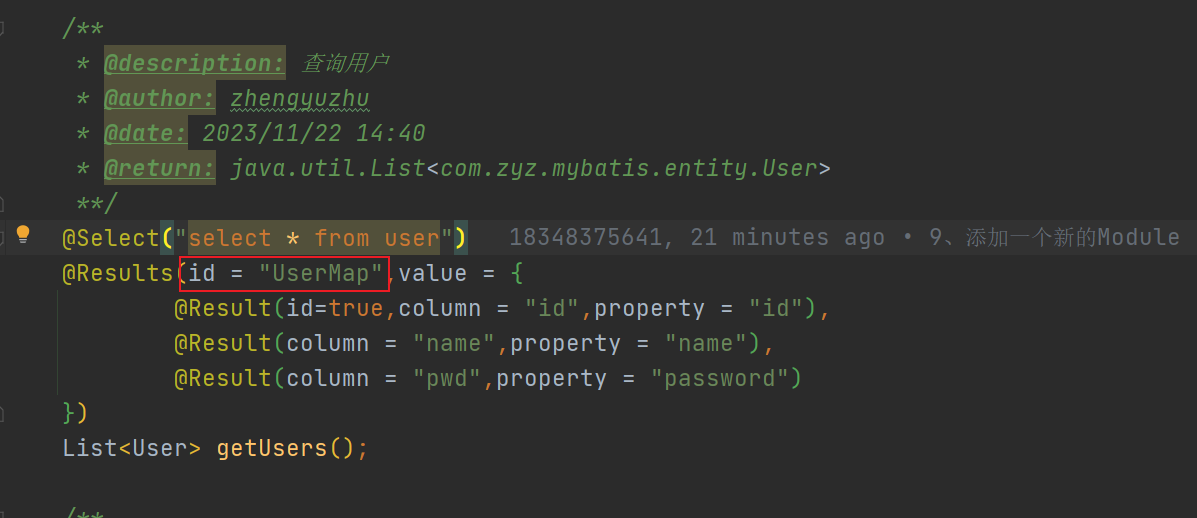

测试单元
/**
* @description: 查询 通过ID
* @author: zhengyuzhu
* @date: 2023/11/22 15:15
**/
@Test
public void testDemo2(){
//第一步:获得SqlSession对象
SqlSession sqlSession = MybatisUtils.getSqlSession();
UserMapper mapper = sqlSession.getMapper(UserMapper.class);
User user = mapper.getUserById(1);
System.out.println(user);
sqlSession.close();
/**
* 输出如下:
*
* [com.zyz.mybatis.mapper.UserMapper.getUserById]-==> Preparing: select * from user where id=?
* [com.zyz.mybatis.mapper.UserMapper.getUserById]-==> Parameters: 1(Integer)
* [com.zyz.mybatis.mapper.UserMapper.getUserById]-<== Total: 1
* User{id=1, name='张三', password='null'}
*
* 复用结果集映射
* [com.zyz.mybatis.mapper.UserMapper.getUserById]-==> Preparing: select * from user where id=?
* [com.zyz.mybatis.mapper.UserMapper.getUserById]-==> Parameters: 1(Integer)
* [com.zyz.mybatis.mapper.UserMapper.getUserById]-<== Total: 1
* User{id=1, name='张三', password='123'}
*
**/
}8.2.2 查询
如果实体类字段 和 数据库字段不一致 需要进行接口 结果集映射
@Results(id = "UserMap",value = {
@Result(id=true,column = "id",property = "id"),
@Result(column = "name",property = "name"),
@Result(column = "pwd",property = "password")
})
这里添加一个 id 可以达到复用的效果。
其它接口使用结果集的时候,可以直接用: @ResultMap(value = ("UserMap"))
接口
/**
* @description: 查询用户
* @author: zhengyuzhu
* @date: 2023/11/22 14:40
* @return: java.util.List<com.zyz.mybatis.entity.User>
**/
@Select("select * from user")
@Results(id = "UserMap",value = {
@Result(id=true,column = "id",property = "id"),
@Result(column = "name",property = "name"),
@Result(column = "pwd",property = "password")
})
List<User> getUsers();
/**
* @description: 查询用户 通过 用户ID 方法存在多个参数,所有参数前面必须加上@Param("id")注解
* @author: zhengyuzhu
* @date: 2023/11/22 15:12
* @param: id
* @return: com.zyz.mybatis.entity.User
**/
@Select("select * from user where id=#{id}")
@ResultMap(value = ("UserMap"))
User getUserById(@Param("id") int id);
测试单元
/**
* @description: 注解开发 查询
* @author: zhengyuzhu
* @date: 2023/11/22 14:41
**/
@Test
public void testDemo1(){
//第一步:获得SqlSession对象
SqlSession sqlSession = MybatisUtils.getSqlSession();
UserMapper mapper = sqlSession.getMapper(UserMapper.class);
List<User> users = mapper.getUsers();
for (User user : users) {
System.out.println(user);
}
sqlSession.close();
/**
* 输出如下:
*
* [com.zyz.mybatis.mapper.UserMapper.getUsers]-==> Preparing: select * from user
* [com.zyz.mybatis.mapper.UserMapper.getUsers]-==> Parameters:
* [com.zyz.mybatis.mapper.UserMapper.getUsers]-<== Total: 6
* User{id=1, name='张三', password='null'}
* User{id=2, name='李四', password='null'}
* User{id=3, name='王五', password='null'}
* User{id=4, name='麻子', password='null'}
* User{id=5, name='李白', password='null'}
* User{id=6, name='小明', password='null'}
*
*
* 采用结果集映射后
*
* [com.zyz.mybatis.mapper.UserMapper.getUsers]-==> Preparing: select * from user
* [com.zyz.mybatis.mapper.UserMapper.getUsers]-==> Parameters:
* [com.zyz.mybatis.mapper.UserMapper.getUsers]-<== Total: 7
* User{id=1, name='张三', password='123'}
* User{id=2, name='李四', password='456'}
* User{id=3, name='王五', password='789'}
* User{id=4, name='麻子', password='321'}
* User{id=5, name='李白', password='654'}
* User{id=6, name='小明', password='987'}
* User{id=7, name='小红', password='666'}
*
*
**/
}
/**
* @description: 查询 通过ID
* @author: zhengyuzhu
* @date: 2023/11/22 15:15
**/
@Test
public void testDemo2(){
//第一步:获得SqlSession对象
SqlSession sqlSession = MybatisUtils.getSqlSession();
UserMapper mapper = sqlSession.getMapper(UserMapper.class);
User user = mapper.getUserById(1);//查询
System.out.println(user);
sqlSession.close();
/**
* 输出如下:
*
* [com.zyz.mybatis.mapper.UserMapper.getUserById]-==> Preparing: select * from user where id=?
* [com.zyz.mybatis.mapper.UserMapper.getUserById]-==> Parameters: 1(Integer)
* [com.zyz.mybatis.mapper.UserMapper.getUserById]-<== Total: 1
* User{id=1, name='张三', password='null'}
*
* 复用结果集映射
* [com.zyz.mybatis.mapper.UserMapper.getUserById]-==> Preparing: select * from user where id=?
* [com.zyz.mybatis.mapper.UserMapper.getUserById]-==> Parameters: 1(Integer)
* [com.zyz.mybatis.mapper.UserMapper.getUserById]-<== Total: 1
* User{id=1, name='张三', password='123'}
*
**/
}
8.2.3 添加
接口
/**
* @description: 添加用户
* @author: zhengyuzhu
* @date: 2023/11/22 15:11
* @param: user
* @return: int
**/
@Insert("insert into user (id,name,pwd) values(#{id},#{name},#{password})")
int addUser(User user);
测试单元
/**
* @description: 添加用户
* @author: zhengyuzhu
* @date: 2023/11/22 15:15
**/
@Test
public void testDemo3(){
//第一步:获得SqlSession对象
SqlSession sqlSession = MybatisUtils.getSqlSession();
UserMapper mapper = sqlSession.getMapper(UserMapper.class);
User user = new User();
user.setId(8);
user.setName("小青");
user.setPassword("888");
mapper.addUser(user);//添加
User userRs = mapper.getUserById(8);
System.out.println("新添加用户 : " + userRs);
sqlSession.close();
/**
* 输出如下:
*
* [com.zyz.mybatis.mapper.UserMapper.addUser]-==> Preparing: insert into user (id,name,pwd) values(?,?,?)
* [com.zyz.mybatis.mapper.UserMapper.addUser]-==> Parameters: 8(Integer), 小青(String), 888(String)
* [com.zyz.mybatis.mapper.UserMapper.addUser]-<== Updates: 1
* [com.zyz.mybatis.mapper.UserMapper.getUserById]-==> Preparing: select * from user where id=?
* [com.zyz.mybatis.mapper.UserMapper.getUserById]-==> Parameters: 8(Integer)
* [com.zyz.mybatis.mapper.UserMapper.getUserById]-<== Total: 1
* 新添加用户 : User{id=8, name='小青', password='888'}
*
**/
}
8.2.4 修改
接口
/**
* @description: 修改用户
* @author: zhengyuzhu
* @date: 2023/11/22 15:11
* @param: user
* @return: int
**/
@Update("update user set name=#{name},pwd=#{password} where id=#{id}")
int updateUser(User user);测试单元
/**
* @description: 修改用户
* @author: zhengyuzhu
* @date: 2023/11/22 15:15
**/
@Test
public void testDemo4(){
//第一步:获得SqlSession对象
SqlSession sqlSession = MybatisUtils.getSqlSession();
UserMapper mapper = sqlSession.getMapper(UserMapper.class);
User userRs = mapper.getUserById(8);
System.out.println("未修改前用户信息 : " + userRs);
User user = new User();
user.setId(8);
user.setName("小紫");
user.setPassword("999");
mapper.updateUser(user);//修改
User userRss = mapper.getUserById(8);
System.out.println("修改后用户信息 : " + userRss);
sqlSession.close();
/**
* 输出如下:
*
* [com.zyz.mybatis.mapper.UserMapper.getUserById]-==> Preparing: select * from user where id=?
* [com.zyz.mybatis.mapper.UserMapper.getUserById]-==> Parameters: 8(Integer)
* [com.zyz.mybatis.mapper.UserMapper.getUserById]-<== Total: 1
* 未修改前用户信息 : User{id=8, name='小青', password='888'}
* [com.zyz.mybatis.mapper.UserMapper.updateUser]-==> Preparing: update user set name=?,pwd=? where id=?
* [com.zyz.mybatis.mapper.UserMapper.updateUser]-==> Parameters: 小紫(String), 999(String), 8(Integer)
* [com.zyz.mybatis.mapper.UserMapper.updateUser]-<== Updates: 1
* [com.zyz.mybatis.mapper.UserMapper.getUserById]-==> Preparing: select * from user where id=?
* [com.zyz.mybatis.mapper.UserMapper.getUserById]-==> Parameters: 8(Integer)
* [com.zyz.mybatis.mapper.UserMapper.getUserById]-<== Total: 1
* 修改后用户信息 : User{id=8, name='小紫', password='999'}
*
**/
}
8.2.5 删除
接口
/**
* @description:删除用户 可以通过@Param("") 给传递的参数 修改别名
* @author: zhengyuzhu
* @date: 2023/11/22 15:11
* @param: id
* @return: int
**/
@Delete("delete from user where id = #{uid}")
int deleteUser(@Param("uid") int id);测试单元
/**
* @description: 删除用户
* @author: zhengyuzhu
* @date: 2023/11/22 15:15
**/
@Test
public void testDemo5(){
//第一步:获得SqlSession对象
SqlSession sqlSession = MybatisUtils.getSqlSession();
UserMapper mapper = sqlSession.getMapper(UserMapper.class);
User userRs = mapper.getUserById(8);
System.out.println("删除前用户信息 : " + userRs);
mapper.deleteUser(8);//删除
User userRss = mapper.getUserById(8);
System.out.println("删除后用户信息 : " + userRss);
sqlSession.close();
/**
* 输出如下:
*
* [com.zyz.mybatis.mapper.UserMapper.getUserById]-==> Preparing: select * from user where id=?
* [com.zyz.mybatis.mapper.UserMapper.getUserById]-==> Parameters: 8(Integer)
* [com.zyz.mybatis.mapper.UserMapper.getUserById]-<== Total: 1
* 删除前用户信息 : User{id=8, name='小紫', password='999'}
* [com.zyz.mybatis.mapper.UserMapper.deleteUser]-==> Preparing: delete from user where id = ?
* [com.zyz.mybatis.mapper.UserMapper.deleteUser]-==> Parameters: 8(Integer)
* [com.zyz.mybatis.mapper.UserMapper.deleteUser]-<== Updates: 1
* [com.zyz.mybatis.mapper.UserMapper.getUserById]-==> Preparing: select * from user where id=?
* [com.zyz.mybatis.mapper.UserMapper.getUserById]-==> Parameters: 8(Integer)
* [com.zyz.mybatis.mapper.UserMapper.getUserById]-<== Total: 0
* 删除后用户信息 : null
*
**/
}
9、Lombok(偷懒的话可以使用)
使用步骤:
- 在IDEA中安装Lombok插件!
- 在项目pom.xml文件中导入Lombok的jar包
<!-- https://mvnrepository.com/artifact/org.projectlombok/lombok -->
<dependency>
<groupId>org.projectlombok</groupId>
<artifactId>lombok</artifactId>
<version>1.18.10</version>
</dependency>
- 在实体类上加注解即可!
@Data
@AllArgsConstructor
@NoArgsConstructor
@Getter and @Setter
@FieldNameConstants
@ToString
@EqualsAndHashCode
@AllArgsConstructor, @RequiredArgsConstructor and @NoArgsConstructor
@Log, @Log4j, @Log4j2, @Slf4j, @XSlf4j, @CommonsLog, @JBossLog, @Flogger, @CustomLog
@Data
@Builder
@SuperBuilder
@Singular
@Delegate
@Value
@Accessors
@Wither
@With
@SneakyThrows
说明:
@Data:无参构造、get、set、toString、hashCode、equals
@AllArgsConstructor
@NoArgsConstructor
@EqualsAndHashCode
@ToString
@Getter and @Setter
10、多对一处理
多对一:
- 多个学生,对应一个老师
- 对于学生而言,关联–多个学生,关联一个老师【多对一】
- 对于老师而言,集合–一个老师,有很多个学生【一对多】
SQL 语句
CREATE TABLE `tb_teacher` (
`id` INT(10) NOT NULL,
`name` VARCHAR(30) DEFAULT NULL,
PRIMARY KEY (`id`)
)ENGINE = INNODB DEFAULT CHARSET=utf8
INSERT INTO tb_teacher(`id`,`name`) VALUES (1,'玉小刚');
CREATE TABLE `tb_student` (
`id` INT(10) NOT NULL,
`name` VARCHAR(30) DEFAULT NULL,
`tid` INT(10) DEFAULT NULL,
PRIMARY KEY (`id`),
KEY `fktid`(`tid`),
CONSTRAINT `fktid` FOREIGN KEY (`tid`) REFERENCES `teacher` (`id`)
)ENGINE = INNODB DEFAULT CHARSET=utf8
INSERT INTO `tb_student`(`id`,`name`,`tid`) VALUES ('1','唐三','1');
INSERT INTO `tb_student`(`id`,`name`,`tid`) VALUES ('2','小舞','1');
INSERT INTO `tb_student`(`id`,`name`,`tid`) VALUES ('3','戴沐白','1');
INSERT INTO `tb_student`(`id`,`name`,`tid`) VALUES ('4','朱朱清','1');
INSERT INTO `tb_student`(`id`,`name`,`tid`) VALUES ('5','奥斯卡','1');
INSERT INTO `tb_student`(`id`,`name`,`tid`) VALUES ('6','宁荣荣','1');
INSERT INTO `tb_student`(`id`,`name`,`tid`) VALUES ('7','马红俊','1');
INSERT INTO `tb_student`(`id`,`name`,`tid`) VALUES ('8','白尘香','1');
测试环境搭建
- 导入Lombok
- 新建实体类Teacher,Student
- mybatis核心配置文件修改
- 建立Mapper接口
- 建立Mapper.XML文件
- 在核心配置文件中绑定注册我们的Mapper接口或者文件!【方式很多,随心选】
- 测试查询是否能够成功!
1、导入Lombok
<dependency>
<groupId>org.projectlombok</groupId>
<artifactId>lombok</artifactId>
<version>1.18.10</version>
</dependency>
2、实体类Teacher,Student
@Data //get,set
@NoArgsConstructor //无参构造
@AllArgsConstructor //有参构造
public class Student {
private Integer id;
private String name;
private Teacher teacher;
}
@Data //get,set
@NoArgsConstructor //无参构造
@AllArgsConstructor //有参构造
public class Teacher {
private Integer id;
private String name;
}
3、mybatis 配置文件
<typeAliases>
<package name="com.zyz.mybatis.entity" />
<package name="com.zyz.mybatis.vo" />
</typeAliases>
<mappers>
<mapper resource="com/zyz/mybatis/mapper/StudentMapper.xml"/>
<mapper resource="com/zyz/mybatis/mapper/TeacherMapper.xml"/>
</mappers>
4、mapper 接口
public interface StudentMapper {
/**
* @description: 查询学生
* @author: zhengyuzhu
* @date: 2023/11/22 22:27
* @return: java.util.List<com.zyz.mybatis.entity.Student>
**/
List<Student> getStudent();
/**
* @description: 查询学生
* @author: zhengyuzhu
* @date: 2023/11/22 22:27
* @return: java.util.List<com.zyz.mybatis.entity.Student>
**/
List<Student> getStudent2();
}
5、mapper.xml
<?xml version="1.0" encoding="UTF-8" ?>
<!DOCTYPE mapper
PUBLIC "-//mybatis.org//DTD Mapper 3.0//EN"
"http://mybatis.org/dtd/mybatis-3-mapper.dtd">
<mapper namespace="com.zyz.mybatis.mapper.StudentMapper">
<!--
1、按照结果集嵌套处理
这里重点说一下 这个结果集映射。如果对查询出来的数据字段 起了 别名。则映射的时候 要用这个别名。
-->
<resultMap id="StudentMap" type="Student">
<!--这里的column是与查询结果的字段名对应,字段重命名了则对应命名后的字段-->
<result property="id" column="sid"/>
<result property="name" column="sname"/>
<!--复杂的属性需要单独处理 对象:association 集合:collection-->
<association property="teacher" javaType="Teacher">
<result property="name" column="tname"/>
<result property="id" column="tid"/>
</association>
</resultMap>
<!--查询学生-->
<select id="getStudent" resultMap="StudentMap">
select s.id sid,s.name sname,t.name tname,s.tid tid
from tb_student s
join tb_teacher t
on s.tid = t.id
</select>
<!--
2、 按照查询嵌套处理
-->
<select id="getStudent2" resultMap="StudentMap2">
select * from tb_student;
</select>
<select id="getTeacher" resultType="Teacher">
select * from tb_teacher where id = #{tid};
</select>
<!--这里将学生和对应老师分开查询,将查询结果组合-->
<resultMap id="StudentMap2" type="Student">
<result property="id" column="id"/>
<result property="name" column="name"/>
<association property="teacher" column="tid" javaType="Teacher" select="getTeacher"/>
</resultMap>
</mapper>
6、测试单元
/**
* @description: 1、按照结果集嵌套处理 多对一
* @author: zhengyuzhu
* @date: 2023/11/22 23:07
**/
@Test
public void testDemo1(){
//第一步:获得SqlSession对象
SqlSession sqlSession = MybatisUtils.getSqlSession();
StudentMapper studentMapper = sqlSession.getMapper(StudentMapper.class);
List<Student> studentList = studentMapper.getStudent();
for(Student student : studentList){
System.out.println(student);
}
sqlSession.close();
/**
* 输出如下:
*
* [com.zyz.mybatis.mapper.StudentMapper.getStudent]-==> Preparing: select s.id sid,s.name sname,t.name tname,s.tid tid from tb_student s join tb_teacher t on s.tid = t.id
* [com.zyz.mybatis.mapper.StudentMapper.getStudent]-==> Parameters:
* [com.zyz.mybatis.mapper.StudentMapper.getStudent]-<== Total: 8
* Student{id=1, name='唐三', teacher=Teacher{id=1, name='玉小刚'}}
* Student{id=2, name='小舞', teacher=Teacher{id=1, name='玉小刚'}}
* Student{id=3, name='戴沐白', teacher=Teacher{id=1, name='玉小刚'}}
* Student{id=4, name='朱朱清', teacher=Teacher{id=1, name='玉小刚'}}
* Student{id=5, name='奥斯卡', teacher=Teacher{id=1, name='玉小刚'}}
* Student{id=6, name='宁荣荣', teacher=Teacher{id=1, name='玉小刚'}}
* Student{id=7, name='马红俊', teacher=Teacher{id=1, name='玉小刚'}}
* Student{id=8, name='白尘香', teacher=Teacher{id=1, name='玉小刚'}}
*
**/
}
/**
* @description: 2、 按照查询嵌套处理 多对一
* @author: zhengyuzhu
* @date: 2023/11/22 23:07
**/
@Test
public void testDemo2(){
//第一步:获得SqlSession对象
SqlSession sqlSession = MybatisUtils.getSqlSession();
StudentMapper studentMapper = sqlSession.getMapper(StudentMapper.class);
List<Student> studentList = studentMapper.getStudent2();
for(Student student : studentList){
System.out.println(student);
}
sqlSession.close();
/**
* 输出如下:
*
* [com.zyz.mybatis.mapper.StudentMapper.getStudent2]-==> Preparing: select * from tb_student;
* [com.zyz.mybatis.mapper.StudentMapper.getStudent2]-==> Parameters:
* [com.zyz.mybatis.mapper.StudentMapper.getTeacher]-====> Preparing: select * from tb_teacher where id = ?;
* [com.zyz.mybatis.mapper.StudentMapper.getTeacher]-====> Parameters: 1(Integer)
* [com.zyz.mybatis.mapper.StudentMapper.getTeacher]-<==== Total: 1
* [com.zyz.mybatis.mapper.StudentMapper.getStudent2]-<== Total: 8
* Student{id=1, name='唐三', teacher=Teacher{id=1, name='玉小刚'}}
* Student{id=2, name='小舞', teacher=Teacher{id=1, name='玉小刚'}}
* Student{id=3, name='戴沐白', teacher=Teacher{id=1, name='玉小刚'}}
* Student{id=4, name='朱朱清', teacher=Teacher{id=1, name='玉小刚'}}
* Student{id=5, name='奥斯卡', teacher=Teacher{id=1, name='玉小刚'}}
* Student{id=6, name='宁荣荣', teacher=Teacher{id=1, name='玉小刚'}}
* Student{id=7, name='马红俊', teacher=Teacher{id=1, name='玉小刚'}}
* Student{id=8, name='白尘香', teacher=Teacher{id=1, name='玉小刚'}}
*
**/
}
11、一对多处理
具体搭建过程同 多对一处理
1、实体类TeacherT,StudentT
同一个环境测试,实体类的字段有所不同。通过起别名的方式完善。
@Data //get,set
@NoArgsConstructor //无参构造
@AllArgsConstructor //有参构造
public class StudentT {
private Integer id;
private String name;
private Integer tid;
}
@Data //get,set
@NoArgsConstructor //无参构造
@AllArgsConstructor //有参构造
public class TeacherT {
private Integer id;
private String name;
private List<StudentT> studentTs;
}
2、mybatis 核心配置文件
<typeAliases>
<package name="com.zyz.mybatis.entity" />
<package name="com.zyz.mybatis.vo" />
</typeAliases>
<mappers>
<mapper resource="com/zyz/mybatis/mapper/StudentMapper.xml"/>
<mapper resource="com/zyz/mybatis/mapper/TeacherMapper.xml"/>
</mappers>
3、mapper 接口
public interface TeacherMapper {
/**
* @description: 1、按照结果嵌套处理 多对一
* @author: zhengyuzhu
* @date: 2023/11/22 23:50
* @return: com.zyz.mybatis.vo.Teacher
**/
TeacherT getTeacherById(Integer id);
/**
* @description: 2、按照查询嵌套处理 一对多
* @author: zhengyuzhu
* @date: 2023/11/23 0:12
* @param: id
* @return: com.zyz.mybatis.vo.TeacherT
**/
TeacherT getTeacher2(Integer id);
}
4、mapper.xml
<?xml version="1.0" encoding="UTF-8" ?>
<!DOCTYPE mapper
PUBLIC "-//mybatis.org//DTD Mapper 3.0//EN"
"http://mybatis.org/dtd/mybatis-3-mapper.dtd">
<mapper namespace="com.zyz.mybatis.mapper.TeacherMapper">
<!--
1、 按结果嵌套查询
-->
<select id="getTeacherById" resultMap="TeacherById">
select t.id id, t.name tname, s.id sid,s.name sname,s.tid tid
from tb_teacher t
join tb_student s
on t.id = s.tid;
</select>
<resultMap id="TeacherById" type="TeacherT">
<result property="id" column="id"/>
<result property="name" column="tname"/>
<!--获取List<Student>中的泛型使用 ofType-->
<collection property="studentTs" ofType="StudentT" javaType="java.util.List">
<result property="id" column="sid"/>
<result property="name" column="sname"/>
<result property="tid" column="tid"/>
</collection>
</resultMap>
<!--
2、按照查询嵌套处理
-->
<select id="getTeacher2" resultMap="TeacherStudent2">
select * from tb_teacher where id = #{tid}
</select>
<resultMap id="TeacherStudent2" type="TeacherT">
<result property="id" column="id"/>
<collection property="studentTs" javaType="java.util.List" ofType="StudentT" select="getStudentByTeacherId" column="id"/>
</resultMap>
<select id="getStudentByTeacherId" resultType="StudentT">
select * from tb_student where tid = #{tid}
</select>
</mapper>
5、测试单元
/**
* @description: 1、 按结果嵌套查询 一对多
* @author: zhengyuzhu
* @date: 2023/11/22 23:07
**/
@Test
public void testDemo3(){
//第一步:获得SqlSession对象
SqlSession sqlSession = MybatisUtils.getSqlSession();
TeacherMapper teacherMapper = sqlSession.getMapper(TeacherMapper.class);
TeacherT teacher = teacherMapper.getTeacherById(1);
System.out.println(teacher);
sqlSession.close();
/**
* 输出如下:
*
[org.apache.ibatis.datasource.pooled.PooledDataSource]-Created connection 1486566962.
[com.zyz.mybatis.mapper.TeacherMapper.getTeacherById]-==> Preparing: select t.id id, t.name tname, s.id sid,s.name sname,s.tid tid from tb_teacher t join tb_student s on t.id = s.tid;
[com.zyz.mybatis.mapper.TeacherMapper.getTeacherById]-==> Parameters:
[com.zyz.mybatis.mapper.TeacherMapper.getTeacherById]-<== Total: 8
TeacherT(id=1, name=玉小刚, studentTs=[
StudentT(id=1, name=唐三, tid=1),
StudentT(id=2, name=小舞, tid=1),
StudentT(id=3, name=戴沐白, tid=1),
StudentT(id=4, name=朱朱清, tid=1),
StudentT(id=5, name=奥斯卡, tid=1),
StudentT(id=6, name=宁荣荣, tid=1),
StudentT(id=7, name=马红俊, tid=1),
StudentT(id=8, name=白尘香, tid=1)
])
[org.apache.ibatis.transaction.jdbc.JdbcTransaction]-Closing JDBC Connection [com.mysql.jdbc.JDBC4Connection@589b3632]
*
**/
}
/**
* @description: 2、 按照查询嵌套处理 一对多
* @author: zhengyuzhu
* @date: 2023/11/22 23:07
**/
@Test
public void testDemo4(){
//第一步:获得SqlSession对象
SqlSession sqlSession = MybatisUtils.getSqlSession();
TeacherMapper teacherMapper = sqlSession.getMapper(TeacherMapper.class);
TeacherT teacher = teacherMapper.getTeacher2(1);
System.out.println(teacher);
sqlSession.close();
/**
* 输出如下:
*
[org.apache.ibatis.datasource.pooled.PooledDataSource]-Created connection 1486566962.
[com.zyz.mybatis.mapper.TeacherMapper.getTeacher2]-==> Preparing: select * from tb_teacher where id = ?
[com.zyz.mybatis.mapper.TeacherMapper.getTeacher2]-==> Parameters: 1(Integer)
[com.zyz.mybatis.mapper.TeacherMapper.getStudentByTeacherId]-====> Preparing: select * from tb_student where tid = ?
[com.zyz.mybatis.mapper.TeacherMapper.getStudentByTeacherId]-====> Parameters: 1(Integer)
[com.zyz.mybatis.mapper.TeacherMapper.getStudentByTeacherId]-<==== Total: 8
[com.zyz.mybatis.mapper.TeacherMapper.getTeacher2]-<== Total: 1
TeacherT(id=1, name=玉小刚, studentTs=[
StudentT(id=1, name=唐三, tid=1),
StudentT(id=2, name=小舞, tid=1),
StudentT(id=3, name=戴沐白, tid=1),
StudentT(id=4, name=朱朱清, tid=1),
StudentT(id=5, name=奥斯卡, tid=1),
StudentT(id=6, name=宁荣荣, tid=1),
StudentT(id=7, name=马红俊, tid=1),
StudentT(id=8, name=白尘香, tid=1)
])
[org.apache.ibatis.transaction.jdbc.JdbcTransaction]-Closing JDBC Connection [com.mysql.jdbc.JDBC4Connection@589b3632]
*
**/
}
12、动态SQL
所谓的动态SQL,本质还是SQL语句,只是我们可以在SQL层面,去执行一个逻辑代码
什么是动态SQL:动态SQL就是 指根据不同的条件生成不同的SQL语句
查询搜索的时候用的多
12.1 搭建环境
大致过程
- 1、创建数据表
- 2、新建实体类
- 3、编写实体类对应Mapper接口
- 4、和Mapper.XML文件
- 5、修改mybatis 核心配置文件
- 6、测试单元
1、创建数据表
CREATE TABLE `blog` (
`id` int(10) NOT NULL COMMENT '博客id',
`title` varchar(100) CHARACTER SET utf8 COLLATE utf8_general_ci NOT NULL COMMENT '博客标题',
`author` varchar(30) CHARACTER SET utf8 COLLATE utf8_general_ci NOT NULL COMMENT '博客作者',
`create_time` varchar(50) CHARACTER SET utf8 COLLATE utf8_general_ci NOT NULL COMMENT '创建时间',
`views` int(30) NOT NULL COMMENT '浏览量'
) ENGINE = InnoDB CHARACTER SET = utf8 COLLATE = utf8_general_ci ROW_FORMAT = Dynamic;
2、创建 Blog 实体类
@Data //get,set
@NoArgsConstructor //无参构造
@AllArgsConstructor //有参构造
public class Blog {
private String id;
private String title;
private String author;
private Date createTime; //属性名和字段名不一致
private int views;
}3、编写实体类对应Mapper接口
/**
* @author zyz
* @version 1.0
* @data 2023/11/23 11:18
* @Description:
*/
public interface BlogMapper {
/**
* @description: IF的使用 查询博客
* @author: zhengyuzhu
* @date: 2023/11/23 11:27
* @param: map
* @return: com.zyz.mybatis.entity.Blog
**/
Blog queryBlogIF(HashMap<String,Object> map);
/**
* @description: choose (when, otherwise)的使用 查询博客
* @author: zhengyuzhu
* @date: 2023/11/23 11:30
* @param: map
* @return: com.zyz.mybatis.entity.Blog
**/
Blog queryBlogChoose(HashMap<String,Object> map);
/**
* @description: trim (where, set)的使用 查询
* @author: zhengyuzhu
* @date: 2023/11/23 11:34
* @param: map
* @return: com.zyz.mybatis.entity.Blog
**/
Blog queryBlogIFTwo(HashMap<String,Object> map);
/**
* @description: trim (where, set)的使用 修改
* @author: zhengyuzhu
* @date: 2023/11/23 11:35
* @param: map
**/
void updateBlog(HashMap<String,Object> map);
/**
* @description: Foreach 的使用
* @author: zhengyuzhu
* @date: 2023/11/23 14:02
* @param: map
* @return: java.util.List<com.zyz.mybatis.entity.Blog>
**/
List<Blog> queryBlogForeach(HashMap<String,Object> map);
/**
* @description: IF的使用 使用代码片段
* @author: zhengyuzhu
* @date: 2023/11/23 11:27
* @param: map
* @return: com.zyz.mybatis.entity.Blog
**/
Blog queryBlogIFThree(HashMap<String,Object> map);
}
4、修改mybatis 核心配置文件
<!-- 1、使用映射器 -->
<mappers>
<mapper resource="com/zyz/mybatis/mapper/BlogMapper.xml"/>
</mappers>
具体的动态SQL 编写以及具体的 测试单元分成如下小节
12.2 IF
mapper.xml 文件
由于 实体类 和 数据库 字段不一致,这里进行了映射
<!-- 结果集映射 -->
<resultMap id="BlogMap" type="Blog">
<!--column数据库中的字段,property实体类中的属性-->
<result column="id" property="id" />
<result column="title" property="title" />
<result column="author" property="author" />
<result column="create_time" property="createTime" />
<result column="views" property="views" />
</resultMap>
<!--IF的使用 查询博客-->
<select id="queryBlogIF" parameterType="map" resultMap="BlogMap">
select * from blog where 1=1
<if test="title != null">
and title = #{title}
</if>
<if test="author != null">
and author = #{author}
</if>
</select>测试单元
/**
* @description: IF 测试
* @author: zhengyuzhu
* @date: 2023/11/23 12:46
**/
@Test
public void testDemo1(){
//第一步:获得SqlSession对象
SqlSession sqlSession = MybatisUtils.getSqlSession();
BlogMapper blogMapper = sqlSession.getMapper(BlogMapper.class);
HashMap<String, Object> blogMap = new HashMap<>();
blogMap.put("title","张麻子娶亲");
blogMap.put("author","张老头");
Blog blog = blogMapper.queryBlogIF(blogMap);//查询
System.out.println(blog);
sqlSession.close();
/**
*
*
* blogMap.put("title","张麻子娶亲");
* blogMap.put("author","张老头");
*
* 查询条件两个:输出如下:
*
* [org.apache.ibatis.datasource.pooled.PooledDataSource]-Created connection 846947180.
* [com.zyz.mybatis.mapper.BlogMapper.queryBlogIF]-==> Preparing: select * from blog where 1=1 and title = ? and author = ?
* [com.zyz.mybatis.mapper.BlogMapper.queryBlogIF]-==> Parameters: 张麻子娶亲(String), 张老头(String)
* [com.zyz.mybatis.mapper.BlogMapper.queryBlogIF]-<== Total: 1
* Blog(id=1, title=张麻子娶亲, author=张老头, createTime=2023-11-23 00:00:00, views=30)
* [org.apache.ibatis.transaction.jdbc.JdbcTransaction]-Closing JDBC Connection [com.mysql.jdbc.JDBC4Connection@327b636c]
*
*
* blogMap.put("title","张麻子娶亲");
* 查询条件一个输出如下
*
* [org.apache.ibatis.datasource.pooled.PooledDataSource]-Created connection 1172131546.
* [com.zyz.mybatis.mapper.BlogMapper.queryBlogIF]-==> Preparing: select * from blog where 1=1 and title = ?
* [com.zyz.mybatis.mapper.BlogMapper.queryBlogIF]-==> Parameters: 张麻子娶亲(String)
* [com.zyz.mybatis.mapper.BlogMapper.queryBlogIF]-<== Total: 1
* Blog(id=1, title=张麻子娶亲, author=张老头, createTime=2023-11-23 00:00:00, views=30)
* [org.apache.ibatis.transaction.jdbc.JdbcTransaction]-Closing JDBC Connection [com.mysql.jdbc.JDBC4Connection@45dd4eda]
*
*
*
*
**/
}
12.3 choose (when, otherwise)
mapper.xml 文件
这里也进行了结果集映射,如上
<!--choose (when, otherwise)的使用 查询博客-->
<select id="queryBlogChoose" parameterType="map" resultMap="BlogMap">
select * from blog
<where>
<choose>
<when test="title != null">
title = #{title}
</when>
<when test="author != null">
and author = #{author}
</when>
<otherwise>
and views = #{views}
</otherwise>
</choose>
</where>
</select>
测试单元
/**
* @description: choose 测试 when otherwise
* @author: zhengyuzhu
* @date: 2023/11/23 13:34
**/
@Test
public void testDemo2(){
//第一步:获得SqlSession对象
SqlSession sqlSession = MybatisUtils.getSqlSession();
BlogMapper blogMapper = sqlSession.getMapper(BlogMapper.class);
HashMap<String, Object> blogMap = new HashMap<>();
// blogMap.put("title","张麻子娶亲");
// blogMap.put("author","张老头");
blogMap.put("views",30);
Blog blog = blogMapper.queryBlogChoose(blogMap);
System.out.println(blog);
sqlSession.close();
/**
*
* 1、多个参数不会拼接,哪个有值 用哪个
*
* blogMap.put("title","张麻子娶亲");
* blogMap.put("author","张老头");
*
* 查询条件两个 但是拼接的时候 第一个有值,就不会在拼接接下来的数据
*
* [org.apache.ibatis.datasource.pooled.PooledDataSource]-Created connection 846947180.
* [com.zyz.mybatis.mapper.BlogMapper.queryBlogChoose]-==> Preparing: select * from blog WHERE title = ?
* [com.zyz.mybatis.mapper.BlogMapper.queryBlogChoose]-==> Parameters: 张麻子娶亲(String)
* [com.zyz.mybatis.mapper.BlogMapper.queryBlogChoose]-<== Total: 1
* Blog(id=1, title=张麻子娶亲, author=张老头, createTime=2023-11-23 00:00:00, views=30)
* [org.apache.ibatis.transaction.jdbc.JdbcTransaction]-Closing JDBC Connection [com.mysql.jdbc.JDBC4Connection@327b636c]
*
*
* blogMap.put("author","张老头");
* 2、查询条件一个输出如下
*
[org.apache.ibatis.datasource.pooled.PooledDataSource]-Created connection 1172131546.
[com.zyz.mybatis.mapper.BlogMapper.queryBlogChoose]-==> Preparing: select * from blog WHERE author = ?
[com.zyz.mybatis.mapper.BlogMapper.queryBlogChoose]-==> Parameters: 张老头(String)
[com.zyz.mybatis.mapper.BlogMapper.queryBlogChoose]-<== Total: 1
Blog(id=1, title=张麻子娶亲, author=张老头, createTime=2023-11-23 00:00:00, views=30)
[org.apache.ibatis.transaction.jdbc.JdbcTransaction]-Closing JDBC Connection [com.mysql.jdbc.JDBC4Connection@45dd4eda]
*
*
*
* 3、查询条件 一个 都不满足情况 otherwise
* blogMap.put("views",30);
*
* [com.zyz.mybatis.mapper.BlogMapper.queryBlogChoose]-==> Preparing: select * from blog WHERE views = ?
* [com.zyz.mybatis.mapper.BlogMapper.queryBlogChoose]-==> Parameters: 30(Integer)
* [com.zyz.mybatis.mapper.BlogMapper.queryBlogChoose]-<== Total: 1
* Blog(id=1, title=张麻子娶亲, author=张老头, createTime=2023-11-23 00:00:00, views=30)
* [org.apache.ibatis.transaction.jdbc.JdbcTransaction]-Closing JDBC Connection [com.mysql.jdbc.JDBC4Connection@45dd4eda]
*
**/
}
12.4 trim (where, set)
mapper.xml 文件
这里也进行了结果集映射,如上
<!--trim (where, set)的使用 查询-->
<select id="queryBlogIFTwo" parameterType="map" resultMap="BlogMap">
select * from blog
<where>
<if test="title != null">
and title = #{title}
</if>
<if test="author != null">
and author = #{author}
</if>
</where>
</select>
<!--trim (where, set)的使用 修改-->
<update id="updateBlog" parameterType="map">
update blog
<set>
<if test="title != null">
title = #{title},
</if>
<if test="author != null">
author = #{author}
</if>
</set>
where id = #{id}
</update>
测试单元
/**
* @description: trim (where, set)的使用 查询
* @author: zhengyuzhu
* @date: 2023/11/23 13:36
**/
@Test
public void testDemo3(){
//第一步:获得SqlSession对象
SqlSession sqlSession = MybatisUtils.getSqlSession();
BlogMapper blogMapper = sqlSession.getMapper(BlogMapper.class);
HashMap<String, Object> blogMap = new HashMap<>();
blogMap.put("title","张麻子娶亲");
blogMap.put("author","张老头");
Blog blog = blogMapper.queryBlogIFTwo(blogMap);//查询
System.out.println(blog);
sqlSession.close();
/**
*
*
* blogMap.put("title","张麻子娶亲");
* blogMap.put("author","张老头");
* 查询条件两个:输出如下:
*
* [org.apache.ibatis.datasource.pooled.PooledDataSource]-Created connection 846947180.
* [com.zyz.mybatis.mapper.BlogMapper.queryBlogIFTwo]-==> Preparing: select * from blog WHERE title = ? and author = ?
* [com.zyz.mybatis.mapper.BlogMapper.queryBlogIFTwo]-==> Parameters: 张麻子娶亲(String), 张老头(String)
* [com.zyz.mybatis.mapper.BlogMapper.queryBlogIFTwo]-<== Total: 1
* Blog(id=1, title=张麻子娶亲, author=张老头, createTime=2023-11-23 00:00:00, views=30)
* [org.apache.ibatis.transaction.jdbc.JdbcTransaction]-Closing JDBC Connection [com.mysql.jdbc.JDBC4Connection@327b636c]
*
*
* blogMap.put("title","张麻子娶亲");
* 查询条件一个输出如下
*
* [org.apache.ibatis.datasource.pooled.PooledDataSource]-Created connection 1172131546.
* [com.zyz.mybatis.mapper.BlogMapper.queryBlogIF]-==> Preparing: select * from blog where 1=1 and title = ?
* [com.zyz.mybatis.mapper.BlogMapper.queryBlogIF]-==> Parameters: 张麻子娶亲(String)
* [com.zyz.mybatis.mapper.BlogMapper.queryBlogIF]-<== Total: 1
* Blog(id=1, title=张麻子娶亲, author=张老头, createTime=2023-11-23 00:00:00, views=30)
* [org.apache.ibatis.transaction.jdbc.JdbcTransaction]-Closing JDBC Connection [com.mysql.jdbc.JDBC4Connection@45dd4eda]
*
*
*
*
**/
}
/**
* @description: trim (where, set)的使用 修改
* @author: zhengyuzhu
* @date: 2023/11/23 13:36
**/
@Test
public void testDemo4(){
//第一步:获得SqlSession对象
SqlSession sqlSession = MybatisUtils.getSqlSession();
BlogMapper blogMapper = sqlSession.getMapper(BlogMapper.class);
HashMap<String, Object> blogMap = new HashMap<>();
blogMap.put("title","张麻子娶亲");
blogMap.put("author","张老头");
Blog blog = blogMapper.queryBlogIFTwo(blogMap);//查询
System.out.println("修改前的数据:" + blog);
HashMap<String, Object> blogMapTwo = new HashMap<>();
blogMapTwo.put("id",1);
blogMapTwo.put("title","如何学号java ?");
blogMapTwo.put("author","小明");
Blog blog1 = new Blog();
blog1.setAuthor("如何学号java ?");
blog1.setAuthor("小明");
blogMapper.updateBlog(blogMapTwo);//修改
HashMap<String, Object> blogMap3 = new HashMap<>();
blogMap3.put("title","如何学号java ?");
Blog blog2 = blogMapper.queryBlogIFTwo(blogMap3);//查询
System.out.println("修改后的数据:" + blog2);
sqlSession.close();
/**
*
*
* blogMapTwo.put("id",1);
* blogMapTwo.put("title","如何学号java ?");
* blogMapTwo.put("author","小明");
* 查询条件两个:输出如下:
*
* [org.apache.ibatis.datasource.pooled.PooledDataSource]-Created connection 846947180.
* [com.zyz.mybatis.mapper.BlogMapper.queryBlogIFTwo]-==> Preparing: select * from blog WHERE title = ? and author = ?
* [com.zyz.mybatis.mapper.BlogMapper.queryBlogIFTwo]-==> Parameters: 张麻子娶亲(String), 张老头(String)
* [com.zyz.mybatis.mapper.BlogMapper.queryBlogIFTwo]-<== Total: 1
* 修改前的数据:Blog(id=1, title=张麻子娶亲, author=张老头, createTime=2023-11-23 00:00:00, views=30)
* [com.zyz.mybatis.mapper.BlogMapper.updateBlog]-==> Preparing: update blog SET title = ?, author = ? where id = ?
* [com.zyz.mybatis.mapper.BlogMapper.updateBlog]-==> Parameters: 如何学号java ?(String), 小明(String), 1(Integer)
* [com.zyz.mybatis.mapper.BlogMapper.updateBlog]-<== Updates: 1
* [com.zyz.mybatis.mapper.BlogMapper.queryBlogIFTwo]-==> Preparing: select * from blog WHERE title = ?
* [com.zyz.mybatis.mapper.BlogMapper.queryBlogIFTwo]-==> Parameters: 如何学号java ?(String)
* [com.zyz.mybatis.mapper.BlogMapper.queryBlogIFTwo]-<== Total: 1
* 修改后的数据:Blog(id=1, title=如何学号java ?, author=小明, createTime=2023-11-23 00:00:00, views=30)
* [org.apache.ibatis.transaction.jdbc.JdbcTransaction]-Closing JDBC Connection [com.mysql.jdbc.JDBC4Connection@327b636c]
*
*
*
**/
}12.5 foreach
更详细的资料参考:mybatis之foreach用法
foreach元素的属性主要有item,index,collection,open,separator,close。
- item:集合中元素迭代时的别名,该参数为必选。
- index:在list和数组中,index是元素的序号,在map中,index是元素的key,该参数可选
- open:foreach代码的开始符号,一般是(和close=")"合用。常用在in(),values()时。该参数可选
- separator:元素之间的分隔符,例如在in()的时候,separator=","会自动在元素中间用“,“隔开,避免手动输入逗号导致sql错误,如in(1,2,)这样。该参数可选。
- close: foreach代码的关闭符号,一般是)和open="("合用。常用在in(),values()时。该参数可选。
- collection: 要做foreach的对象,作为入参时,List对象默认用"list"代替作为键,数组对象有"array"代替作为键,Map对象没有默认的键。当然在作为入参时可以使用@Param("keyName")来设置键,设置keyName后,list,array将会失效。 除了入参这种情况外,还有一种作为参数对象的某个字段的时候。举个例子:如果User有属性List ids。入参是User对象,那么这个collection = "ids".如果User有属性Ids ids;其中Ids是个对象,Ids有个属性List id;入参是User对象,那么collection = "ids.id"
在使用foreach的时候最关键的也是最容易出错的就是collection属性,该属性是必须指定的,但是在不同情况下,该属性的值是不一样的,主要有一下3种情况:
- 如果传入的是单参数且参数类型是一个List的时候,collection属性值为list .
- 如果传入的是单参数且参数类型是一个array数组的时候,collection的属性值为array .
- 如果传入的参数是多个的时候,我们就需要把它们封装成一个Map了,当然单参数也可以封装成map,实际上如果你在传入参数的时候,在MyBatis里面也是会把它封装成一个Map的,map的key就是参数名,所以这个时候collection属性值就是传入的List或array对象在自己封装的map里面的key.
针对最后一条,我们来看一下官方说法:
注意 你可以将一个 List 实例或者数组作为参数对象传给 MyBatis,当你这么做的时候,MyBatis 会自动将它包装在一个 Map 中并以名称为键。List 实例将会以“list”作为键,而数组实例的键将是“array”。
所以,不管是多参数还是单参数的list,array类型,都可以封装为map进行传递。如果传递的是一个List,则mybatis会封装为一个list为key,list值为object的map,如果是array,则封装成一个array为key,array的值为object的map,如果自己封装呢,则colloection里放的是自己封装的map里的key值。
mapper.xml 文件
这里也进行了结果集映射
<!--
foreach元素的属性主要有item,index,collection,open,separator,close。
● item:集合中元素迭代时的别名,该参数为必选。
● index:在list和数组中,index是元素的序号,在map中,index是元素的key,该参数可选
● open:foreach代码的开始符号,一般是(和close=")"合用。常用在in(),values()时。该参数可选
● separator:元素之间的分隔符,例如在in()的时候,separator=","会自动在元素中间用“,“隔开,避免手动输入逗号导致sql错误,如in(1,2,)这样。该参数可选。
● close: foreach代码的关闭符号,一般是)和open="("合用。常用在in(),values()时。该参数可选。
● collection: 要做foreach的对象,作为入参时,List对象默认用"list"代替作为键,数组对象有"array"代替作为键,Map对象没有默认的键。
当然在作为入参时可以使用@Param("keyName")来设置键,设置keyName后,list,array将会失效。 除了入参这种情况外,还有一种作为参数对象的某个字段的时候。
举个例子:如果User有属性List ids。入参是User对象,那么这个collection = "ids".如果User有属性Ids ids;其中Ids是个对象,Ids有个属性List id;
入参是User对象,那么collection = "ids.id"
select * from blog where 1=1 and (id=1 or id=2 or id=3)
我们现在传递一个万能的map,这map中可以存在一个集合!
-->
<select id="queryBlogForeach" parameterType="map" resultMap="BlogMap">
select * from blog
<where>
<foreach collection="ids" item="id" open="and (" close=")" separator="or">
id = #{id}
</foreach>
</where>
</select>
测试单元
/**
* @description: Foreach 的使用
* @author: zhengyuzhu
* @date: 2023/11/23 14:03
**/
@Test
public void testDemo5(){
//第一步:获得SqlSession对象
SqlSession sqlSession = MybatisUtils.getSqlSession();
BlogMapper blogMapper = sqlSession.getMapper(BlogMapper.class);
ArrayList<Object> idList = new ArrayList<>();
idList.add(1);
idList.add(2);
idList.add(3);
HashMap<String, Object> blogMap = new HashMap<>();
blogMap.put("ids",idList);
List<Blog> blogList = blogMapper.queryBlogForeach(blogMap);//查询
for(Blog blog : blogList){
System.out.println(blog);
}
sqlSession.close();
/**
*
*
* 查询条件两个:输出如下:
*
* [org.apache.ibatis.datasource.pooled.PooledDataSource]-Created connection 360062456.
* [com.zyz.mybatis.mapper.BlogMapper.queryBlogForeach]-==> Preparing: select * from blog WHERE ( id = ? or id = ? or id = ? )
* [com.zyz.mybatis.mapper.BlogMapper.queryBlogForeach]-==> Parameters: 1(Integer), 2(Integer), 3(Integer)
* [com.zyz.mybatis.mapper.BlogMapper.queryBlogForeach]-<== Total: 3
* Blog(id=1, title=如何学号java ?, author=小明, createTime=2023-11-23 00:00:00, views=30)
* Blog(id=2, title=张麻子学java, author=李老头, createTime=2023-11-22 00:00:00, views=560)
* Blog(id=3, title=张麻子学数据库, author=米老头, createTime=2023-11-22 00:00:00, views=760)
* [org.apache.ibatis.transaction.jdbc.JdbcTransaction]-Closing JDBC Connection [com.mysql.jdbc.JDBC4Connection@15761df8]
*
*
*
**/
}
12.5 代码片段(复用)
有的时候,我们可以能会将一些功能的部分抽取出来,方便复用!
- 使用SQL标签抽取公共的部分
<sql id="if-title-author">
<if test="title != null">
title = #{title}
</if>
<if test="author != null">
and author = #{author}
</if>
</sql>
- 在需要使用的地方使用Include标签引用即可
这里有对结果集进行映射
<!--复用 SQL代码片段的方式-->
<select id="queryBlogIFThree" parameterType="map" resultMap="BlogMap">
select * from blog
<where>
<include refid="if-title-author"></include>
</where>
</select>
测试单元
/**
* @description: IF 的使用 复用代码片段
* @author: zhengyuzhu
* @date: 2023/11/23 14:33
**/
@Test
public void testDemo6(){
//第一步:获得SqlSession对象
SqlSession sqlSession = MybatisUtils.getSqlSession();
BlogMapper blogMapper = sqlSession.getMapper(BlogMapper.class);
HashMap<String, Object> blogMap = new HashMap<>();
blogMap.put("title","张麻子娶亲");
blogMap.put("author","张老头");
Blog blog = blogMapper.queryBlogIF(blogMap);//查询
System.out.println(blog);
sqlSession.close();
/**
*
*
* blogMap.put("title","张麻子娶亲");
* blogMap.put("author","张老头");
*
* 查询条件两个:输出如下:
*
* [org.apache.ibatis.datasource.pooled.PooledDataSource]-Created connection 846947180.
* [com.zyz.mybatis.mapper.BlogMapper.queryBlogIF]-==> Preparing: select * from blog where 1=1 and title = ? and author = ?
* [com.zyz.mybatis.mapper.BlogMapper.queryBlogIF]-==> Parameters: 张麻子娶亲(String), 张老头(String)
* [com.zyz.mybatis.mapper.BlogMapper.queryBlogIF]-<== Total: 1
* Blog(id=1, title=张麻子娶亲, author=张老头, createTime=2023-11-23 00:00:00, views=30)
* [org.apache.ibatis.transaction.jdbc.JdbcTransaction]-Closing JDBC Connection [com.mysql.jdbc.JDBC4Connection@327b636c]
*
*
* blogMap.put("title","张麻子娶亲");
* 查询条件一个输出如下
*
* [org.apache.ibatis.datasource.pooled.PooledDataSource]-Created connection 1172131546.
* [com.zyz.mybatis.mapper.BlogMapper.queryBlogIF]-==> Preparing: select * from blog where 1=1 and title = ?
* [com.zyz.mybatis.mapper.BlogMapper.queryBlogIF]-==> Parameters: 张麻子娶亲(String)
* [com.zyz.mybatis.mapper.BlogMapper.queryBlogIF]-<== Total: 1
* Blog(id=1, title=张麻子娶亲, author=张老头, createTime=2023-11-23 00:00:00, views=30)
* [org.apache.ibatis.transaction.jdbc.JdbcTransaction]-Closing JDBC Connection [com.mysql.jdbc.JDBC4Connection@45dd4eda]
*
*
*
*
**/
}13、缓存
13.1 简介
1、什么是缓存[Cache]?
- 存在内存中的临时数据。
- 将用户经常查询的数据放在缓存(内存)中,用户去查询数据就不用从磁盘上(关系型数据库查询文件)查询,从缓存中查询,从而提高查询效率,解决了高并发系统的性能问题。
2. 为什么使用缓存?
- 减少和数据库的交互次数,减少系统开销,提高系统效率。
3. 什么样的数据能使用缓存?
- 经常查询并且不经常改变的数据。【可以使用缓存】
资料参考:mybatis一级缓存二级缓存
13.2 Mybatis缓存
- Mybatis包含一个非常强大的查询缓存特性,它可以非常方便地定制和配置缓存。缓存可以极大的提升查询效率。
- Mybatis系统中默认定义了两级缓存:一级缓存和二级缓存
1、默认情况下,只有一级缓存开启。(SqlSession级别的缓存,也称为本地缓存)
2、二级缓存需要手动开启和配置,它是基于namespace级别的缓存。
3、为了提高扩展性,Mybatis定义了缓存接口Cache,我们可以通过实现Cache接口来自 定义二级缓存。
13.2.1 一级缓存
13.2.1.1 原理说明
Mybatis对缓存提供支持,但是在没有配置的默认情况下,它只开启一级缓存,一级缓存只是相对于同一个SqlSession而言。所以在参数和SQL完全一样的情况下,我们使用同一个SqlSession对象调用一个Mapper方法,往往只执行一次SQL,因为使用SelSession第一次查询后,MyBatis会将其放在缓存中,以后再查询的时候,如果没有声明需要刷新,并且缓存没有超时的情况下,SqlSession都会取出当前缓存的数据,而不会再次发送SQL到数据库。

为什么要使用一级缓存,不用多说也知道个大概。但是还有几个问题我们要注意一下。
1、一级缓存的生命周期有多长?
a、MyBatis在开启一个数据库会话时,会 创建一个新的SqlSession对象,SqlSession对象中会有一个新的Executor对象。Executor对象中持有一个新的PerpetualCache对象;当会话结束时,SqlSession对象及其内部的Executor对象还有PerpetualCache对象也一并释放掉。
b、如果SqlSession调用了close()方法,会释放掉一级缓存PerpetualCache对象,一级缓存将不可用。
c、如果SqlSession调用了clearCache(),会清空PerpetualCache对象中的数据,但是该对象仍可使用。
d、SqlSession中执行了任何一个update操作(update()、delete()、insert()) ,都会清空PerpetualCache对象的数据,但是该对象可以继续使用
2、怎么判断某两次查询是完全相同的查询?
mybatis认为,对于两次查询,如果以下条件都完全一样,那么就认为它们是完全相同的两次查询。
2.1 传入的statementId
2.2 查询时要求的结果集中的结果范围
2.3. 这次查询所产生的最终要传递给JDBC java.sql.Preparedstatement的Sql语句字符串(boundSql.getSql() )
2.4 传递给java.sql.Statement要设置的参数值
13.2.1.2 缓存成功
测试步骤:
- 开启日志!
- 测试在一个Session中查询两次相同记录
- 查看日志输出
/**
* @description: 测试缓存 同一个session 连续查询两次
* @author: zhengyuzhu
* @date: 2023/11/23 15:02
**/
@Test
public void test07(){
//第一步:获得SqlSession对象
SqlSession sqlSession = MybatisUtils.getSqlSession();
//方式一:getMapper
StudentMapper studentMapper = sqlSession.getMapper(StudentMapper.class);
Student student = studentMapper.queryStudentById(1);
System.out.println(student);
System.out.println("-----------------");
Student student1 = studentMapper.queryStudentById(1);
System.out.println(student1);
//关闭SqlSession
sqlSession.close();
/**
* 只进行了一次查询 输出如下 :
*
* [org.apache.ibatis.datasource.pooled.PooledDataSource]-Created connection 341748265.
* [org.apache.ibatis.transaction.jdbc.JdbcTransaction]-Setting autocommit to false on JDBC Connection [com.mysql.jdbc.JDBC4Connection@145eaa29]
* [com.zyz.mybatis.mapper.StudentMapper.queryStudentById]-==> Preparing: select * from student where stuNo = ?
* [com.zyz.mybatis.mapper.StudentMapper.queryStudentById]-==> Parameters: 1(Integer)
* [com.zyz.mybatis.mapper.StudentMapper.queryStudentById]-<== Total: 1
* Student{stuNo=1, stuName='张三', cardID=1115, classID=1}
* -----------------
* Student{stuNo=1, stuName='张三', cardID=1115, classID=1}
* [org.apache.ibatis.transaction.jdbc.JdbcTransaction]-Resetting autocommit to true on JDBC Connection [com.mysql.jdbc.JDBC4Connection@145eaa29]
* [org.apache.ibatis.transaction.jdbc.JdbcTransaction]-Closing JDBC Connection [com.mysql.jdbc.JDBC4Connection@145eaa29]
*
**/
}
13.2.1.3 缓存失效的情况
一级缓存失效的情况:
- 查询不同的东西;
- 增删改操作,可能会改变原来的数据,所以必定会刷新缓存!
- 查询不同的Mapper.xml
- 手动清理缓存!
/**
* @description: 测试缓存失效的情况 1、进行不同的数据查询
* @author: zhengyuzhu
* @date: 2023/11/23 15:02
**/
@Test
public void test08(){
//第一步:获得SqlSession对象
SqlSession sqlSession = MybatisUtils.getSqlSession();
//方式一:getMapper
StudentMapper studentMapper = sqlSession.getMapper(StudentMapper.class);
Student student = studentMapper.queryStudentById(1);
System.out.println(student);
System.out.println("-----------------");
Student student1 = studentMapper.queryStudentById(2);
System.out.println(student1);
//关闭SqlSession
sqlSession.close();
/**
* 1、查询不同的数据的时候,缓存会失效
*
* [org.apache.ibatis.transaction.jdbc.JdbcTransaction]-Opening JDBC Connection
* [org.apache.ibatis.datasource.pooled.PooledDataSource]-Created connection 341748265.
* [org.apache.ibatis.transaction.jdbc.JdbcTransaction]-Setting autocommit to false on JDBC Connection [com.mysql.jdbc.JDBC4Connection@145eaa29]
* [com.zyz.mybatis.mapper.StudentMapper.queryStudentById]-==> Preparing: select * from student where stuNo = ?
* [com.zyz.mybatis.mapper.StudentMapper.queryStudentById]-==> Parameters: 1(Integer)
* [com.zyz.mybatis.mapper.StudentMapper.queryStudentById]-<== Total: 1
* Student{stuNo=1, stuName='张三', cardID=1115, classID=1}
* -----------------
* [com.zyz.mybatis.mapper.StudentMapper.queryStudentById]-==> Preparing: select * from student where stuNo = ?
* [com.zyz.mybatis.mapper.StudentMapper.queryStudentById]-==> Parameters: 2(Integer)
* [com.zyz.mybatis.mapper.StudentMapper.queryStudentById]-<== Total: 1
* Student{stuNo=2, stuName='李四', cardID=1116, classID=2}
* [org.apache.ibatis.transaction.jdbc.JdbcTransaction]-Resetting autocommit to true on JDBC Connection [com.mysql.jdbc.JDBC4Connection@145eaa29]
* [org.apache.ibatis.transaction.jdbc.JdbcTransaction]-Closing JDBC Connection [com.mysql.jdbc.JDBC4Connection@145eaa29]
*
**/
}
/**
* @description: 测试缓存失效的情况 2、进行了删除或者修改操作
* @author: zhengyuzhu
* @date: 2023/11/23 15:02
**/
@Test
public void test09(){
//第一步:获得SqlSession对象
SqlSession sqlSession = MybatisUtils.getSqlSession();
//方式一:getMapper
StudentMapper studentMapper = sqlSession.getMapper(StudentMapper.class);
Student student1 = studentMapper.queryStudentById(1);
System.out.println("修改前数据:" + student1);
System.out.println("-----------------");
Student student = new Student();
student.setStuNo(1);
student.setStuName("张麻子666");
student.setClassID(8);
student.setCardID(8);
studentMapper.updateStudent(student); //修改
System.out.println("-----------------");
Student student2 = studentMapper.queryStudentById(1);
System.out.println("修改后数据:" + student2);
//关闭SqlSession
sqlSession.close();
/**
* 1、查询相同的数据,但是中间进行了修改操作
*
* [org.apache.ibatis.transaction.jdbc.JdbcTransaction]-Opening JDBC Connection
* [org.apache.ibatis.datasource.pooled.PooledDataSource]-Created connection 341748265.
* [org.apache.ibatis.transaction.jdbc.JdbcTransaction]-Setting autocommit to false on JDBC Connection [com.mysql.jdbc.JDBC4Connection@145eaa29]
* [com.zyz.mybatis.mapper.StudentMapper.queryStudentById]-==> Preparing: select * from student where stuNo = ?
* [com.zyz.mybatis.mapper.StudentMapper.queryStudentById]-==> Parameters: 1(Integer)
* [com.zyz.mybatis.mapper.StudentMapper.queryStudentById]-<== Total: 1
* 修改前数据:Student{stuNo=1, stuName='张三', cardID=1115, classID=1}
* -----------------
* [com.zyz.mybatis.mapper.StudentMapper.updateStudent]-==> Preparing: update student set stuNo = ?, stuName = ?, cardid = ?, classid = ? where stuNo = ?
* [com.zyz.mybatis.mapper.StudentMapper.updateStudent]-==> Parameters: 1(Integer), 张麻子666(String), 8(Integer), 8(Integer), 1(Integer)
* [com.zyz.mybatis.mapper.StudentMapper.updateStudent]-<== Updates: 1
* -----------------
* [com.zyz.mybatis.mapper.StudentMapper.queryStudentById]-==> Preparing: select * from student where stuNo = ?
* [com.zyz.mybatis.mapper.StudentMapper.queryStudentById]-==> Parameters: 1(Integer)
* [com.zyz.mybatis.mapper.StudentMapper.queryStudentById]-<== Total: 1
* 修改后数据:Student{stuNo=1, stuName='张麻子666', cardID=8, classID=8}
* [org.apache.ibatis.transaction.jdbc.JdbcTransaction]-Rolling back JDBC Connection [com.mysql.jdbc.JDBC4Connection@145eaa29]
* [org.apache.ibatis.transaction.jdbc.JdbcTransaction]-Resetting autocommit to true on JDBC Connection [com.mysql.jdbc.JDBC4Connection@145eaa29]
* [org.apache.ibatis.transaction.jdbc.JdbcTransaction]-Closing JDBC Connection [com.mysql.jdbc.JDBC4Connection@145eaa29]
*
**/
}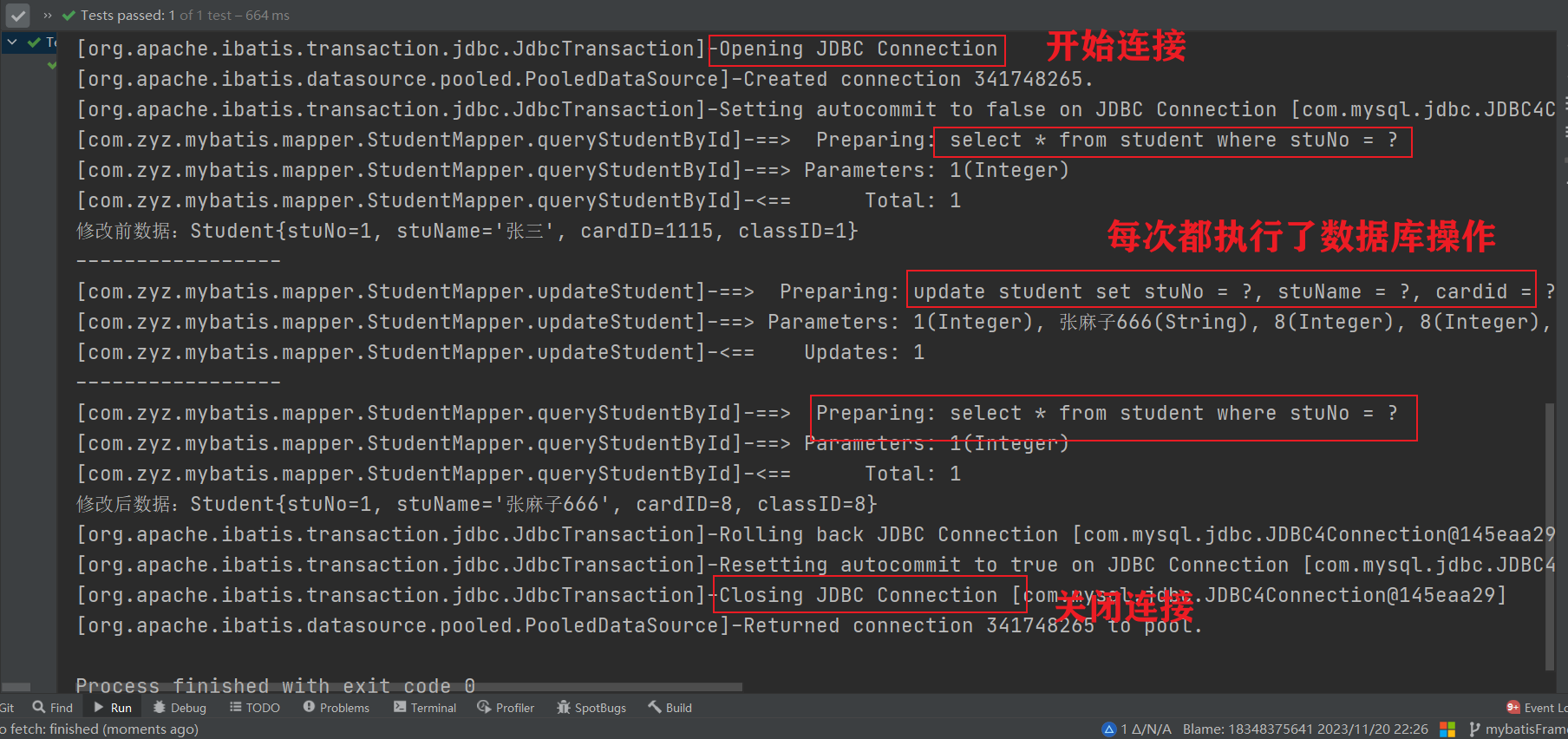
手动清理缓存!
sqlSession.clearCache(); //手动清除缓存
/**
* @description: 手动清除缓存 缓存失效。查询两次
* @author: zhengyuzhu
* @date: 2023/11/23 15:21
**/
@Test
public void test10(){
//第一步:获得SqlSession对象
SqlSession sqlSession = MybatisUtils.getSqlSession();
//方式一:getMapper
StudentMapper studentMapper = sqlSession.getMapper(StudentMapper.class);
Student student = studentMapper.queryStudentById(1);
System.out.println(student);
System.out.println("-----------------");
sqlSession.clearCache(); //手动清除缓存
Student student1 = studentMapper.queryStudentById(1);
System.out.println(student1);
//关闭SqlSession
sqlSession.close();
/**
* 1、同一个连接,连续两次查询。第二次查询拿缓存数据
*
* [org.apache.ibatis.datasource.pooled.PooledDataSource]-Created connection 341748265.
* [org.apache.ibatis.transaction.jdbc.JdbcTransaction]-Setting autocommit to false on JDBC Connection [com.mysql.jdbc.JDBC4Connection@145eaa29]
* [com.zyz.mybatis.mapper.StudentMapper.queryStudentById]-==> Preparing: select * from student where stuNo = ?
* [com.zyz.mybatis.mapper.StudentMapper.queryStudentById]-==> Parameters: 1(Integer)
* [com.zyz.mybatis.mapper.StudentMapper.queryStudentById]-<== Total: 1
* Student{stuNo=1, stuName='张三', cardID=1115, classID=1}
* -----------------
* Student{stuNo=1, stuName='张三', cardID=1115, classID=1}
* [org.apache.ibatis.transaction.jdbc.JdbcTransaction]-Resetting autocommit to true on JDBC Connection [com.mysql.jdbc.JDBC4Connection@145eaa29]
* [org.apache.ibatis.transaction.jdbc.JdbcTransaction]-Closing JDBC Connection [com.mysql.jdbc.JDBC4Connection@145eaa29]
*
*
*
* 2、手动清除缓存
*
* [org.apache.ibatis.transaction.jdbc.JdbcTransaction]-Opening JDBC Connection
* [org.apache.ibatis.datasource.pooled.PooledDataSource]-Created connection 341748265.
* [org.apache.ibatis.transaction.jdbc.JdbcTransaction]-Setting autocommit to false on JDBC Connection [com.mysql.jdbc.JDBC4Connection@145eaa29]
* [com.zyz.mybatis.mapper.StudentMapper.queryStudentById]-==> Preparing: select * from student where stuNo = ?
* [com.zyz.mybatis.mapper.StudentMapper.queryStudentById]-==> Parameters: 1(Integer)
* [com.zyz.mybatis.mapper.StudentMapper.queryStudentById]-<== Total: 1
* Student{stuNo=1, stuName='张三', cardID=1115, classID=1}
* -----------------
* [com.zyz.mybatis.mapper.StudentMapper.queryStudentById]-==> Preparing: select * from student where stuNo = ?
* [com.zyz.mybatis.mapper.StudentMapper.queryStudentById]-==> Parameters: 1(Integer)
* [com.zyz.mybatis.mapper.StudentMapper.queryStudentById]-<== Total: 1
* Student{stuNo=1, stuName='张三', cardID=1115, classID=1}
* [org.apache.ibatis.transaction.jdbc.JdbcTransaction]-Resetting autocommit to true on JDBC Connection [com.mysql.jdbc.JDBC4Connection@145eaa29]
* [org.apache.ibatis.transaction.jdbc.JdbcTransaction]-Closing JDBC Connection [com.mysql.jdbc.JDBC4Connection@145eaa29]
*
**/
}
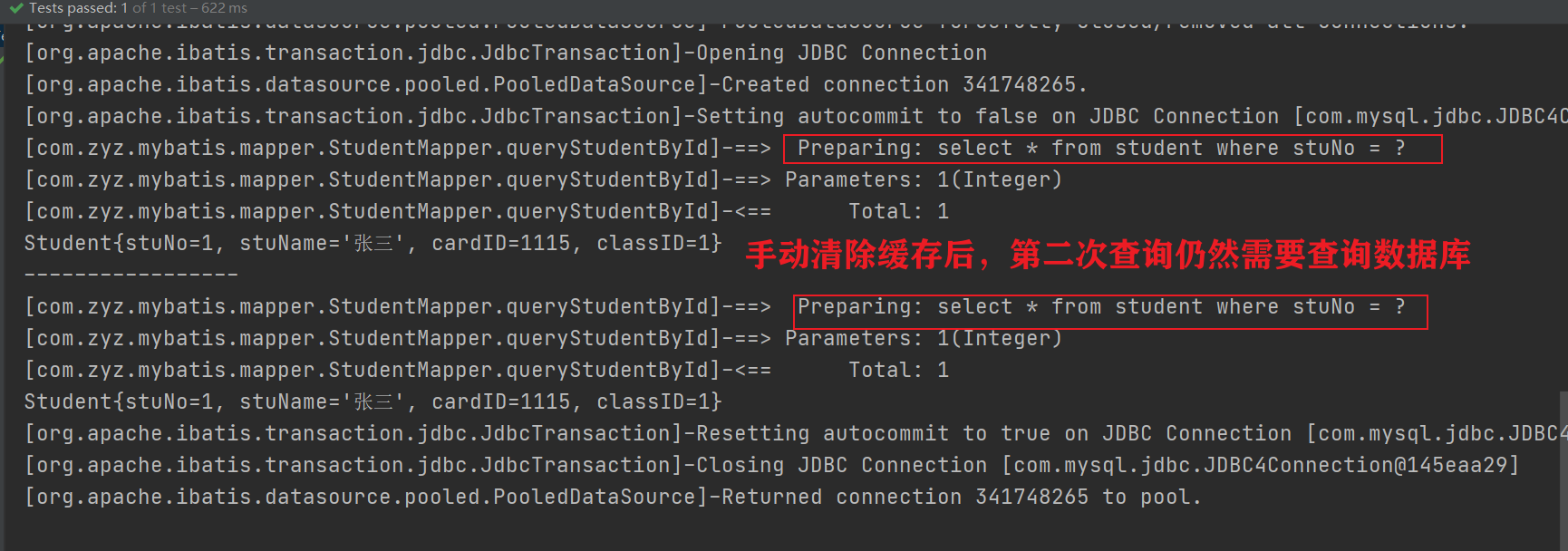
扩展
@Test
public void test01() throws IOException {
SqlSessionFactory sqlSessionFactory = getSqlSessionFactory();
SqlSession session = sqlSessionFactory.openSession();
EmployeeMapper mapper = session.getMapper(EmployeeMapper.class);
try {
Employee map = mapper.getEmployeeById(1);
session.clearCache();
Employee map2 = mapper.getEmployeeById(1);
System.out.println(map == map2);
session.commit();
} finally {
session.close();
}
}
输出结果为false.
因为手动清清除缓存,缓存失效13.2.2 二级缓存
13.2.2.1 原理说明
MyBatis的二级缓存是Application级别的缓存,它可以提高对数据库查询的效率,以提高应用的性能。
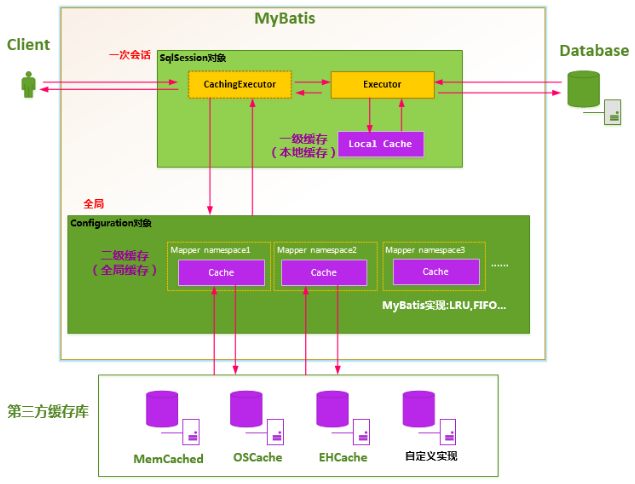
SqlSessionFactory层面上的二级缓存默认是不开启的,二级缓存的开席需要进行配置,实现二级缓存的时候,MyBatis要求返回的POJO必须是可序列化的。 也就是要求实现Serializable接口,配置方法很简单,只需要在映射XML文件配置就可以开启缓存了<cache/>,如果我们配置了二级缓存就意味着:
- 映射语句文件中的所有select语句将会被缓存。
- 映射语句文件中的所欲insert、update和delete语句会刷新缓存。
- 缓存会使用默认的Least Recently Used(LRU,最近最少使用的)算法来收回。
- 根据时间表,比如No Flush Interval,(CNFI没有刷新间隔),缓存不会以任何时间顺序来刷新。
- 缓存会存储列表集合或对象(无论查询方法返回什么)的1024个引用
- 缓存会被视为是read/write(可读/可写)的缓存,意味着对象检索不是共享的,而且可以安全的被调用者修改,不干扰其他调用者或线程所做的潜在修改。
13.2.2.1 详细说明
详细说明:
二级缓存:全局缓存;基于namespace级别的缓存。一个namespace对应一个二级缓存。
工作机制:1.一个会话,查询一条数据,这个数据会被放在当前会话的一级缓存中。
2,如果会话被关闭了,一级缓存中的数据会被保存带二级缓存。新的会话查询信息就会参照二级缓存。
3.sqlSession ====> Employee====>employee
sqlSession ====>DepartmentMapper=====>Department
不同的namespace查出的数据会放在自己对应的缓存中。
效果:查出的数据首先放在一级缓存中,只有一级缓存被关闭或者提交以后,一级缓存数据才会转移到二级缓存
使用步骤:
1.开启全局缓存配置。<settings><settingname="cacheEnabled"value="true"/></settings>
2.因为是namespace级别,需要搭配每个xxxMapper.xml中配置二级缓存<cache></cache>
<cache flushInterval="60000" size="512" readOnly="true" eviction="FIFO" type="" />
eviction:缓存的回收策略:
LRU – 最近最少使用的:移除最长时间不被使用的对象。
FIFO – 先进先出:按对象进入缓存的顺序来移除它们。
SOFT – 软引用:移除基于垃圾回收器状态和软引用规则的对象。
WEAK – 弱引用:更积极地移除基于垃圾收集器状态和弱引用规则的对象。
flushInterval:缓存刷新间隔。缓存多久清空一次,默认不清空。设置一个毫秒值。
readOnly:是否只读。true:mybatis认为所有从缓存中获取数据的操作都是只读操作,不会修改数据。
mybatis为了加快获取速度,直接就会将数据在缓存中的引用交给用户。不安全,速度快。
false:mybatis觉得获取的数据可能被修改。mybatis会利用序列化和反序列化的技术克隆一份新的数据给用户。安全,速度快。
size:缓存放多少元素。
type:指定自定义缓存全类名。实现cache接口即可。
3.pojo需要实现序列换接口。
和缓存相关的配置/属性:
1.cacheEnabled:如果是false,关闭二级缓存,不关闭一级缓存。
2.每个select标签都有userCache="true"属性:对一级缓存没有影响。设置为false,二级缓存失效。
3.每个增删改标签都有flushCache="true"属性:一级缓存和二级缓存都会被清空。
4.在查询标签中flushCache="false"属性:如果设置为true,查完会清空,一级二级缓存都会被清空,都不会用缓存。
5.sqlSession.clearn():跟session有关,只会清除一级缓存。
6.localCacheScope:<settings><settingname="localCacheScope"value="SESSION"/></settings>本地缓存作用域。
一级缓存SESSION:当前会话的所有数据保存到回话缓存中。STATEMENT:禁用一级缓存。
缓存首先一进来去查二级缓存,二级缓存没有去找一级缓存,一级缓存没有去找数据库。二级缓存----->一级缓存-------->数据库。
自定义缓存 implements Cache,重写接口中的保存等方法,比如说保存到redis.
13.2.2.2 测试案例
步骤:
- 在mybatis-config.xml开启全局缓存
<settings>
<setting name="cacheEnabled" value="true"/>
</settings>
- 在要使用二级缓存的Mapper中开启
<!--在当前Mapper.xml中使用二级缓存-->
<cache/>也可以自定义参数
<!--开启本mapper的namespace下的二级缓存-->
<!--
eviction:代表的是缓存回收策略,目前MyBatis提供以下策略。
(1) LRU,最近最少使用的,一处最长时间不用的对象
(2) FIFO,先进先出,按对象进入缓存的顺序来移除他们
(3) SOFT,软引用,移除基于垃圾回收器状态和软引用规则的对象
(4) WEAK,弱引用,更积极的移除基于垃圾收集器状态和弱引用规则的对象。这里采用的是LRU,
移除最长时间不用的对形象
flushInterval:刷新间隔时间,单位为毫秒,这里配置的是100秒刷新,如果你不配置它,那么当
SQL被执行的时候才会去刷新缓存。
size:引用数目,一个正整数,代表缓存最多可以存储多少个对象,不宜设置过大。设置过大会导致内存溢出。
这里配置的是1024个对象
readOnly:只读,意味着缓存数据只能读取而不能修改,这样设置的好处是我们可以快速读取缓存,缺点是我们没有
办法修改缓存,他的默认值是false,不允许我们修改
-->
<cache eviction="LRU" flushInterval="100000" readOnly="true" size="1024"/>
<!--
在当前Mapper.xml中使用二级缓存:
1、默认:<cache/>
2、自定义参数 <cache eviction="FIFO" flushInterval="60000" size="512" readOnly="true"/>
-->测试
- 问题:如果没有自定义参数,则会报错,我们需要将实体类序列化
Cause: java.io.NotSerializableException: com.zyz.mybatis.entity.Student小结:
- 只要开启了二级缓存,在同一个Mapper下就有效;
- 所有的数据都会先放在一级缓存中;
- 只有当会话提交或者关闭的时候,才会提交到二级缓存中!
单元测试
一定要提交或者关闭
/**
* @description: 二级缓存 创建两个sqlSession
* @author: zhengyuzhu
* @date: 2023/11/23 15:51
**/
@Test
public void test11(){
SqlSessionFactory sqlSessionFactory = null;
try {
//使用Mybatis第一步:获取sqlSessionFactory对象
String resource = "mybatis-config.xml";
InputStream inputStream = Resources.getResourceAsStream(resource);
sqlSessionFactory = new SqlSessionFactoryBuilder().build(inputStream);
} catch (Exception e) {
e.printStackTrace();
}
//第一步:获得SqlSession对象
SqlSession sqlSession = sqlSessionFactory.openSession();
//方式一:getMapper
StudentMapper studentMapper = sqlSession.getMapper(StudentMapper.class);
Student student1 = studentMapper.queryStudentById(1);
System.out.println("第1次查询:" + student1);
Student student2 = studentMapper.queryStudentById(1);
System.out.println("第2次查询:" + student2);
// 效果:查出的数据首先放在一级缓存中,只有一级缓存被关闭或者提交以后,
// 一级缓存数据才会转移到二级缓存
sqlSession.commit();
System.out.println("二级缓存观测点");
SqlSession sqlSession2 = sqlSessionFactory.openSession();
StudentMapper studentMapper2 = sqlSession2.getMapper(StudentMapper.class);
Student student3 = studentMapper2.queryStudentById(1);
System.out.println("第一次执行:"+ student3);
Student student4 = studentMapper2.queryStudentById(1);
System.out.println("第2次执行:"+ student4);
sqlSession2.commit();
System.out.println("四个对象是否相同:" + ((student1 == student2) && (student3 == student4) &&(student1 == student4)));
//关闭SqlSession
sqlSession.close();
sqlSession2.close();
/**
* 二级缓存开启
*
* [org.apache.ibatis.transaction.jdbc.JdbcTransaction]-Opening JDBC Connection
* [org.apache.ibatis.datasource.pooled.PooledDataSource]-Created connection 921760190.
* [org.apache.ibatis.transaction.jdbc.JdbcTransaction]-Setting autocommit to false on JDBC Connection [com.mysql.jdbc.JDBC4Connection@36f0f1be]
* [com.zyz.mybatis.mapper.StudentMapper.queryStudentById]-==> Preparing: select * from student where stuNo = ?
* [com.zyz.mybatis.mapper.StudentMapper.queryStudentById]-==> Parameters: 1(Integer)
* [com.zyz.mybatis.mapper.StudentMapper.queryStudentById]-<== Total: 1
* 第1次查询:Student{stuNo=1, stuName='张三', cardID=1115, classID=1}
* [com.zyz.mybatis.mapper.StudentMapper]-Cache Hit Ratio [com.zyz.mybatis.mapper.StudentMapper]: 0.0
* 第2次查询:Student{stuNo=1, stuName='张三', cardID=1115, classID=1}
* 二级缓存观测点
* [com.zyz.mybatis.mapper.StudentMapper]-Cache Hit Ratio [com.zyz.mybatis.mapper.StudentMapper]: 0.3333333333333333
* 第一次执行:Student{stuNo=1, stuName='张三', cardID=1115, classID=1}
* [com.zyz.mybatis.mapper.StudentMapper]-Cache Hit Ratio [com.zyz.mybatis.mapper.StudentMapper]: 0.5
* 第2次执行:Student{stuNo=1, stuName='张三', cardID=1115, classID=1}
* 四个对象是否相同:true
* [org.apache.ibatis.transaction.jdbc.JdbcTransaction]-Resetting autocommit to true on JDBC Connection [com.mysql.jdbc.JDBC4Connection@36f0f1be]
* [org.apache.ibatis.transaction.jdbc.JdbcTransaction]-Closing JDBC Connection [com.mysql.jdbc.JDBC4Connection@36f0f1be]
**/
}
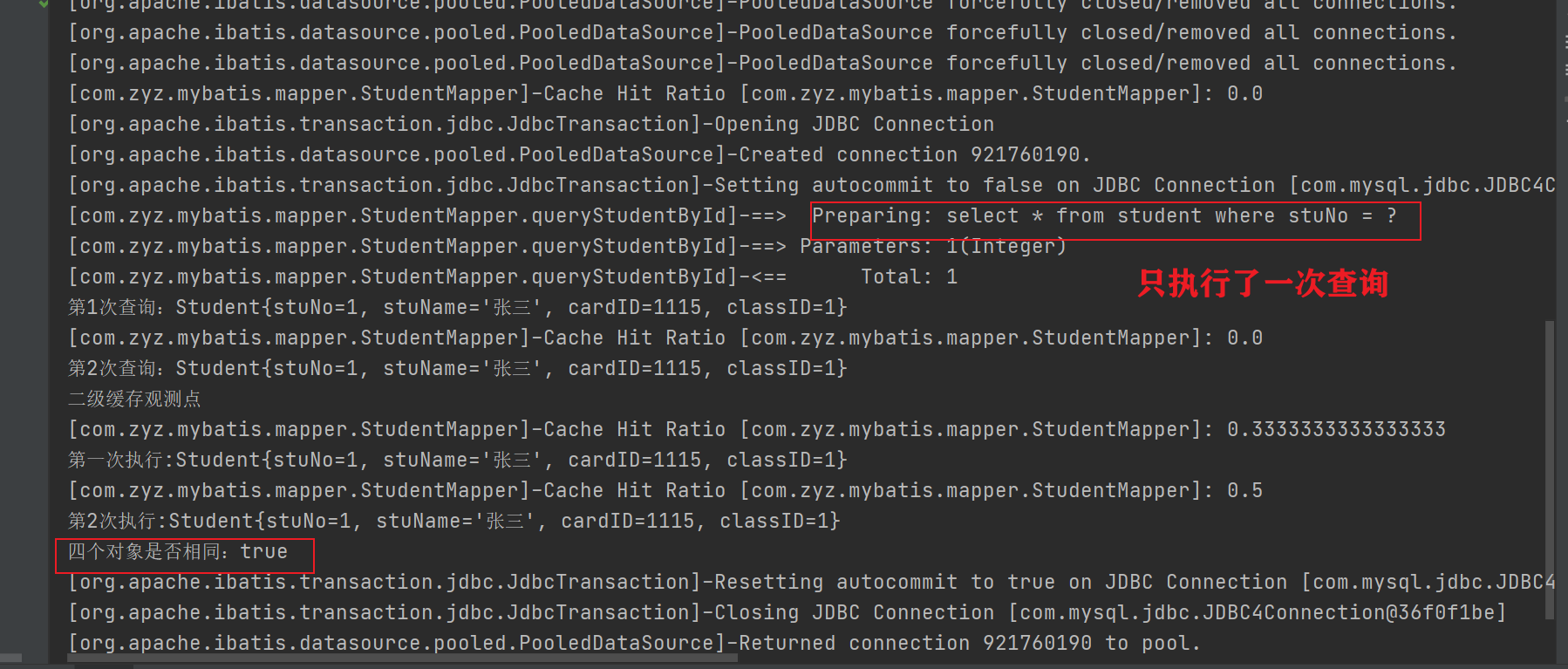




 浙公网安备 33010602011771号
浙公网安备 33010602011771号